Content warning: The story gets dark. That’s shown in some of the images, especially those that reflect the relationship between Laurelin and Astarion.
If you somehow got to this post directly:
- This is another post in my BG3 series.
- I’m not a skilled player. Don’t expect tips for soloing Honor mode.
- It’s both a playthrough write-up and a photo essay. There will be too many screenshots.
- I’ll continue my custom of analyzing one aspect of the system. In this post, it will be “spell slots”.
- I’ll try to avoid spoilers, but there will be some. This post will be more spoilery than my previous ones because of how I’ll tell Laurelin’s story. Of course, every link to the BG3 wiki or a YouTube video is a spoiler.
- Some of the few people who bother to look at my BG3 series tell me that they just skim them to avoid the D&D details. To make things easier, I’ll include the word “system” in every section header that focuses on a rules discussion. The other sections will be story-related.
For the first time in a while, I played a “Tav”. My original goals for this playthrough were:
- Character roles:
- Avatar: Laurelin, Lore Bard
- Astarion: Gloomstalker / Rogue build
- Karlach: Barbarian at start, with a tentative push towards “salami thrower”; may respec to Heat build
- Gale: Illusionist Wizard.
- To have a relationship with Astarion, as I fill out the list of experiencing a relationship with all the Origin characters.
- To play a game in Balanced difficulty (a step above the easiest, Explorer) and see if I could be more successful in the early levels than I was when I last tried it.
As with my previous playthrough, much happened that was unexpected.
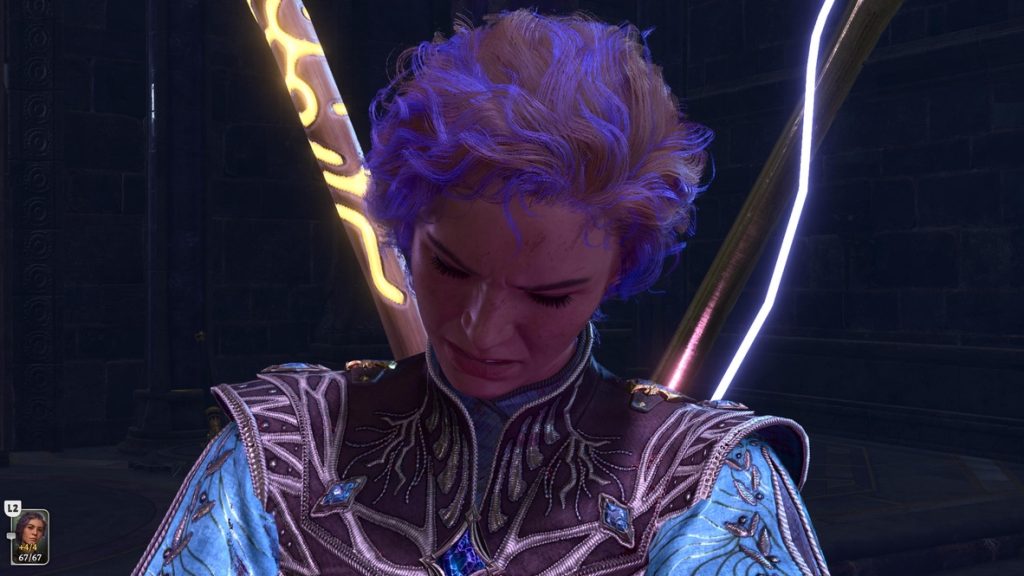
It’s going to be a long post. Get ready.
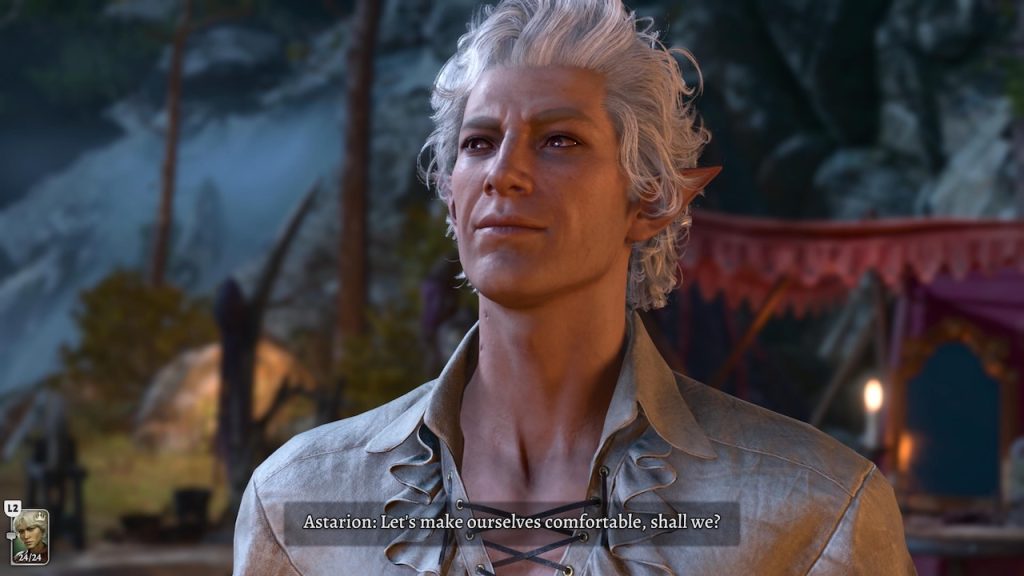
Overall gameplay report: I was able to manage with Balanced difficulty from the beginning of the game to its end. It may be that I’ve learned enough tricks to move beyond Explorer difficulty.
When it comes to the characters, I’ll start with Astarion. His story is tightly coupled to that of Laurelin, so I’ll wait until we get to her for that part of the experience.
Astarion – System
I played him as a Gloomstalker Assassin. The result was excellent. It was rare for him not to take out at least one enemy every turn, even the most powerful ones.
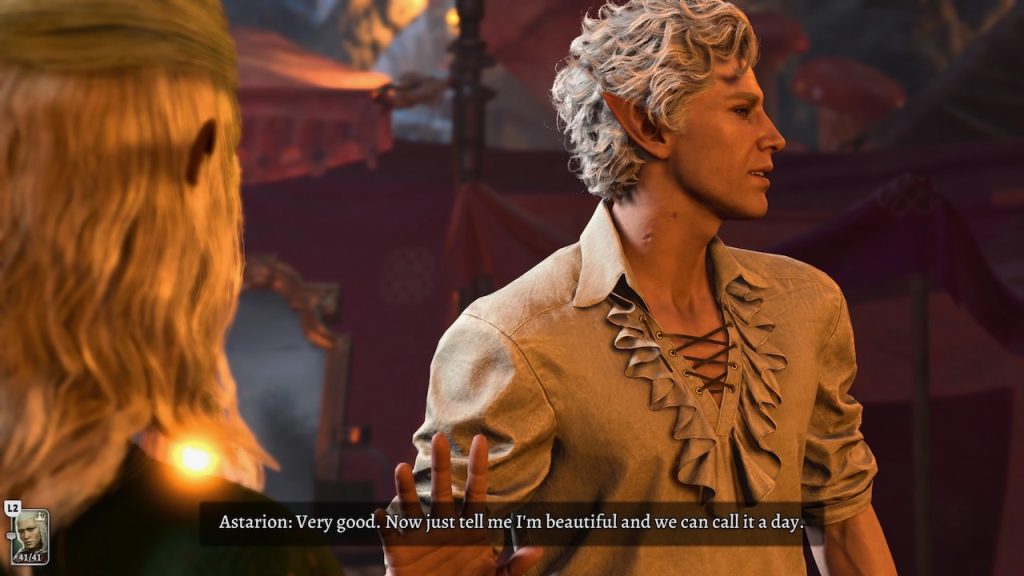
As seems to happen often when I play Astarion, he made use of the Shapeshifter’s Boon Ring to add to his skill rolls. As a result, when he was in the field he rarely looked like himself:

Apart from the Gloomstalker Ranger build, there’s another reason for his success: In past playthroughs, I tended to hoard the special arrows (like Arrow of Lightning or Arrow of Many Targets) until “later”. This time I tried to use as soon as I got them. At the end of the game, his inventory was still filled with excess arrows that I never got the chance to shoot.
Lesson: Never shoot just a plain arrow unless the game’s interface forces you to.
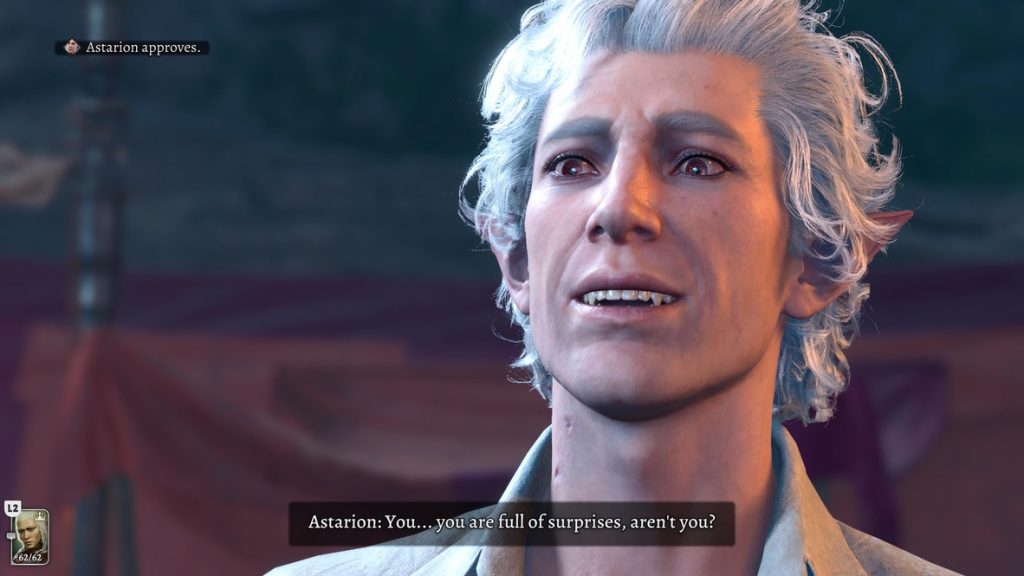
An example of how the game’s interface can prevent your use of special arrows is the Gloomstalker Ranger skill Dread Ambusher. This lets you shoot an extra arrow during the first turn of combat. It may be that if you play BG3 using a keyboard+mouse you can fire a special arrow using this skill. I play the game on a PS5 using a controller, and I couldn’t figure a way to do it. All of Astarion’s Dread Ambusher arrows were “vanilla”.
Verdict: Success, would play again.

Gale – System
I based the choice of Illusion Wizard on this video:
Improved Minor Illusion is skilled unique to Wizards of the Illusion School. I found its benefits as described in the video to be overrated.
Don’t get me wrong. Minor Illusion is an incredibly useful spell. It attracts enemies to a given spot, allowing you set up ambushes or peel apart large groups.
However, when used in this way, you have to go into Turn-based mode; otherwise the illusion (of a cat who attracts attention with her meows) will last only a couple of seconds. That pretty much negates the benefit of casting the spell as a Bonus Action.
Lots of classes have access to Minor Illusion. When the time came, I swapped out Gale without much thought.


Verdict: Wizards are powerful in their later levels, but I’d pick one of the Evocation or Abjuration school over the Illusion school. This was a fail.
System tangent: spell slots
Before you completely skip this section, it’s got some interesting tidbits of the history of magic systems in tabletop role-playing games. Maybe give it a try.
The origin of “spell slots” comes from the SF stories written by Jack Vance (no, not the 2024 VP nominee) in the 1950s and 1960s. In the The Dying Earth stories, magicians had to carefully pick which spells they’d memorize at the start of the day. The reason given was that the spells were so puissant (Vance had a marvelous gift for language) that even a highly-trained brain could only hold so many.
Fast forward to the early 70s. The originators of what would eventually be called the Dungeons & Dragons system had to find a way to limit spellcasters somehow. The “feel” of fantasy stories demanded that magic be powerful and impressive. But if you let a magic-user cast (e.g.) a Fireball every turn, no one would want to play any other class.
One solution is to limit the effects of the Fireball. This makes spells in general less impressive.
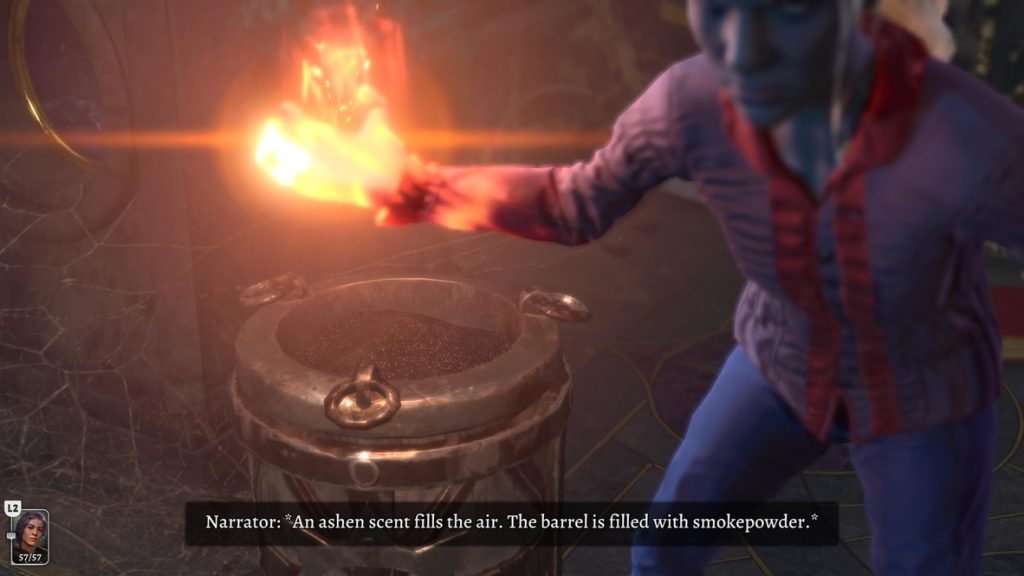
D&D‘s solution was to use the idea of magic from The Dying Earth: There were only so many spells that a magic-user could have prepared for given day.
Spell-casters also had books (generally called grimoires in fantasy literature, called “spellbooks” in D&D) from which a spell-caster could learn their spells. Part of the reason for this was to give magic-users another motive that’s found in fantasy literature: to go on a quest to learn a new spell to add to their grimoire.
As a spell-caster’s level increases, the number of “spell slots” they have increases. Some of the new spell slots can be used for more powerful spells.
A spell-caster in D&D is navigating a jigsaw puzzle: You can cast only so many spells per day, of a given power, from a given list.
A system tangent within a system tangent
In 1978 the SF writer Larry Niven published a novella, The Magic Goes Away. In it, magic was a finite quantity that was spent every time a spell-caster used it. The name Niven gave to the measurement of this quantity was “mana”.
I don’t know if Niven knew this (he probably did, he’s quite a smart man): In Oceanian cultures, mana is the name of a spiritual force that permeates the universe. In Cunningham’s Guide to Hawaiian Magic & Spirituality, I learned that in the Hawai’ian culture there were those who were especially skilled at working with mana and applied it to their work (healing, craftsmanship, surfing, even hula).
(In this context, mana sounds like The Force. If Lucas had used “mana” instead of “midichlorians”, the world would be a better place.)
In 1978, Greg Stafford‘s game company Chaosium published a tabletop role-playing game called Runequest. As far as I know, that was the first published game to introduce a point-based system for limiting the use of magic by spell-casters. [Edit: In Oct-2025 I learned that point-based magic systems existed before Runequest, but I believe (without proof) that it was the first professionally-published game that used the concept.]
A spell-caster had a certain number of “mana points” (I assume the word came from Niven’s story). Each spell cost an amount of mana. More powerful spells cost more mana.
A spell-caster could decide how they wanted to spend their mana as the immediate situation required. They could cast many low-powered spells, or cast perhaps one or two high-powered spells, with the mana they had available.
In my mind, this is a more “rational” system for handling magic. It’s found in almost every fantasy tabletop role-playing game and video game except for D&D.
(See Isaac Bonewits’ Authentic Thaumaturgy for yet another approach to magic in a game system.)
Getting back to the original system tangent
Spell slots are yet another reason I hate D&D.
I find the system to be too restrictive. It makes it difficult to be a spell-caster for the first couple of character levels. I also think it’s a difficult system to explain to brand-new players.
Another reason I hate the D&D magic system is the rigid nature and names of the spells. You have to accept that there’s a ranged fire-based cantrip, but no ranged lightning-based cantrip.
Spells named “Otiluke’s Resilient Sphere”, “Tasha’s Hideous Laughter”, “Otto’s Irresistible Dance”, or “Melf’s Acid Arrow” imply that the game world had magicians named Otiluke, Tasha, Otto, and Melf. This ties the spells to a specific game universe; in modern D&D, this is the world of Forgotten Realms.
What if you want to set your campaign in a different universe? Then you have to go through all the spells and rename them, or accept that your game’s past includes the D&D past, or have some other contrivance.
I repeat what I said before: I play BG3 despite the system, not because of it. The spell system is the part I dislike the most.
Maybe there’s some optimal way to play an Illusion Wizard. I feel no desire to seek it out.
OK, enough ranting. End of tangent.
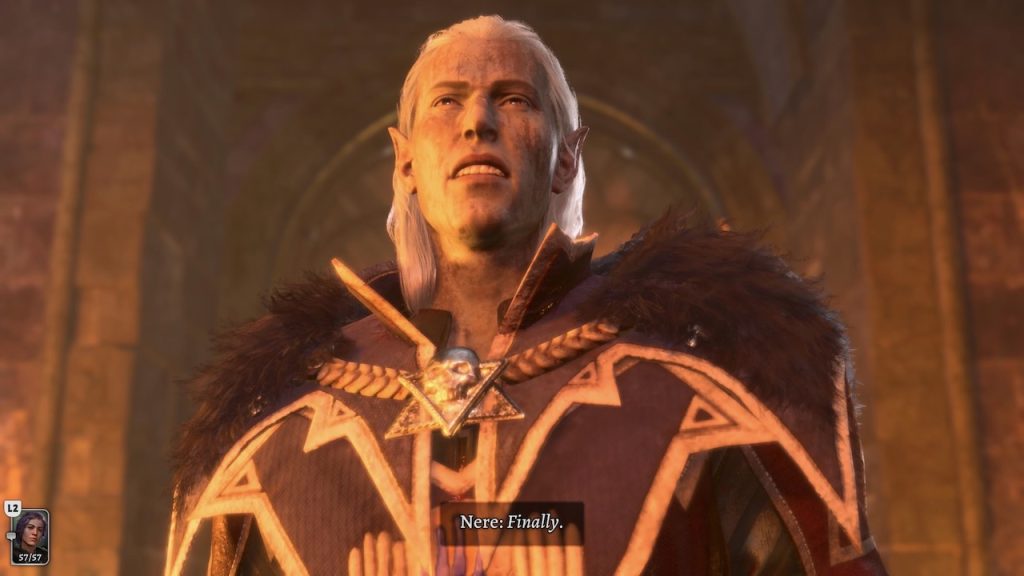
Karlach – System
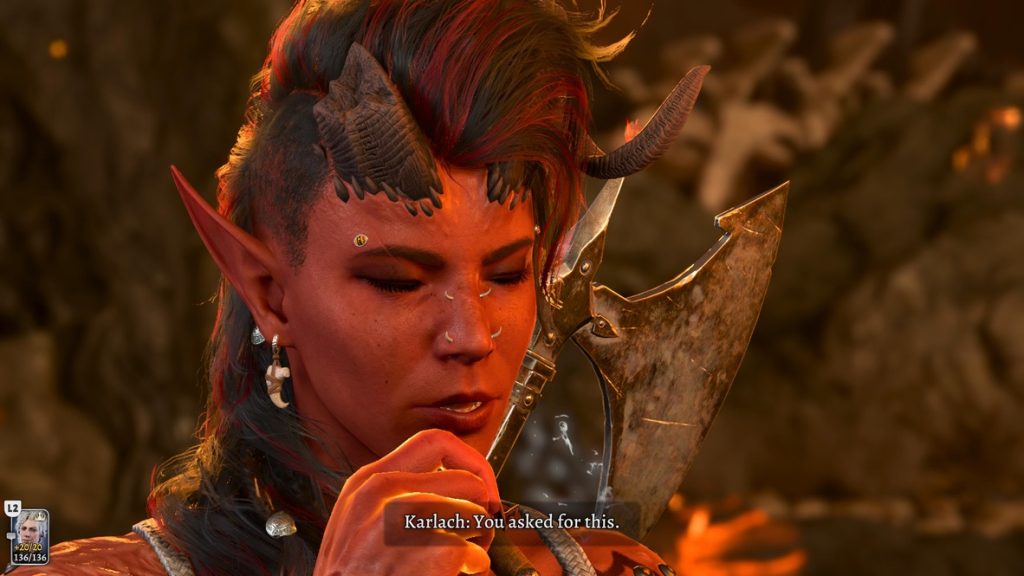
I saw this video about a “salami” build and thought I’d try it on Karlach:
I followed the directions until Level 9, which is when the build “kicks in”. You literally have your character throw a salami (the only food item that you can wield as a weapon) using a Wildheart Barbarian’s Chimpanzee Aspect. With that Aspect, when the Barbarian throws a food item it causes the target to go Blind.
Cute.
However, when I reached that point, I realized that specific Barbarian classes, skills, and salamis to Blind opponents were not necessary. There’s a spear that’s easy to get early in the game, Vision of the Absolute, that anyone can use to basically do the same thing (plus a Barbarian can pick up skills that improves the spear’s damage).
Once I discarded the “Salami Slinger”, I wanted to try out a Heat-based Karlach build. Here’s another example of a Heat build:
If you go to that link, you’ll find many people disparage the build because it isn’t as effective as some other Barbarian builds. For me, using Balanced difficulty, it worked just fine. I agree there are better Barbarian builds out there (it’s hard to beat the Throwzerker). But it was fun to “Flame On!” and incinerate opponents who dared attack Karlach.
A Heat-based build has the bonus that it makes use of items that other characters/builds won’t want to use. There are too many builds out there that require both the Callous Glow Ring and the Coruscation Ring, for example. A Heat build has no competition for gear.
The disadvantage of a Heat build is that it requires some micromanagement of your attacks. You can’t have more than 7 levels of Heat. If you don’t remember to activate the skill Heat Convergence to use up those levels at the right time, you’re wasting any benefits the build gives to your attacks.
Verdicts: Salami build is cute but unnecessary; would not play again. A Heat-based build is fun; would play again if I don’t required an optimized character.
Halsin – System
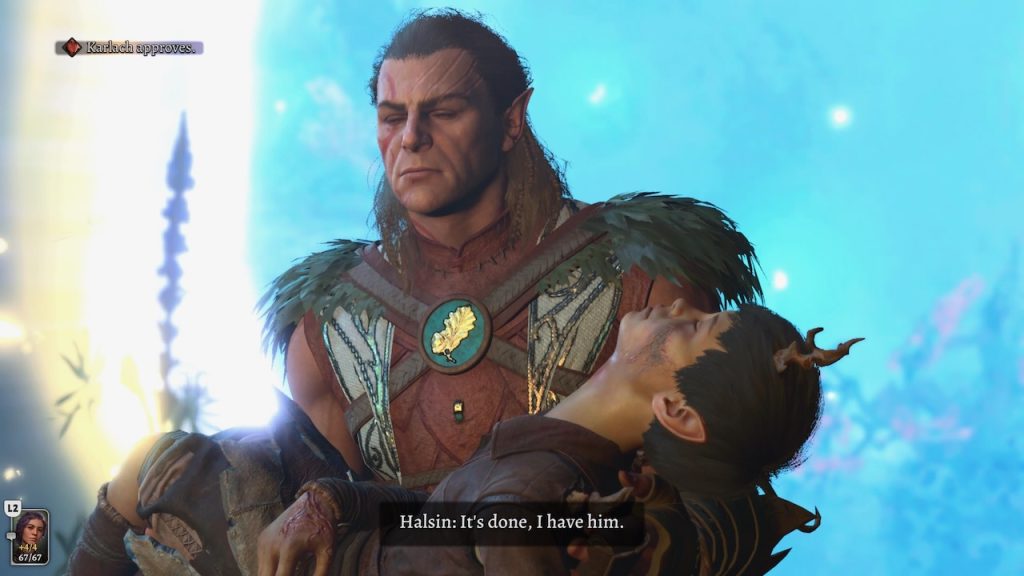
In my previous playthrough write-up, I said that I’d try using Halsin in my party as soon as he became available to see if I could get extra “oomph” out of the BarBEARian build:
I used him in place of Karlach for a while, since Halsin becomes available as a playable character at around level 7 or 8, but Karlach’s Heat build doesn’t yield interesting results until Level 9.
He was resilient with the gear I gave him, and didn’t take much damage. But he didn’t do as much damage as the other characters. I retired him in favor of Shadowheart when a certain story event required it.
Verdict: Having Halsin in your party at least once is useful for a story event towards the end of the game. If you want to experience his sex scene, you’ll need him to accompany you for a while to increase his approval of you. Otherwise he doesn’t bring too much to the party, other than as a tank. I’ll play him again for the role-playing/story benefits, but for now I don’t see him as a core party member.
Shadowheart – System
There’s story-related reason why I brought Shadowheart into the game at level 10 even though I hadn’t used her before. Let me explain…

OK, Shadowheart, whatever you say. Please remember this favor when I plan to romance you in Playthrough 11 or 12.
Actually, I’ll get to Shadowheart’s role in the story when I discuss Laurelin. For now, I’ll focus on her build.
The build was simple: 12 levels of War Cleric, wearing all the Dark Justiciar gear.
This worked well. Her damage output was equivalent to Karlach’s, without as much micro-management.
Towards the end of the game, I swapped them when needed. Karlach’s Heat build is not useful against opponents who are either Resistant or Immune to Fire. I used Shadowheart for those encounters.
Verdict: Would definitely play again, though I might indulge in some optimization over a simple 12 levels of War Cleric (e.g., a couple of levels of Paladin).
The Three Protectors
Before we get to the central character’s story, let’s meet the Three Protectors for this run: Sabrina, Marie, and Chase.

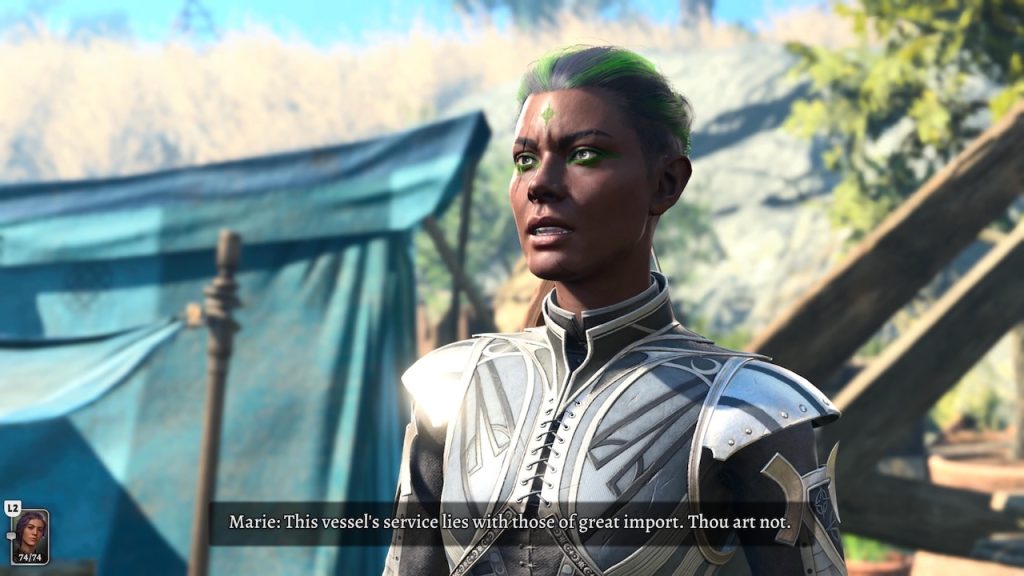
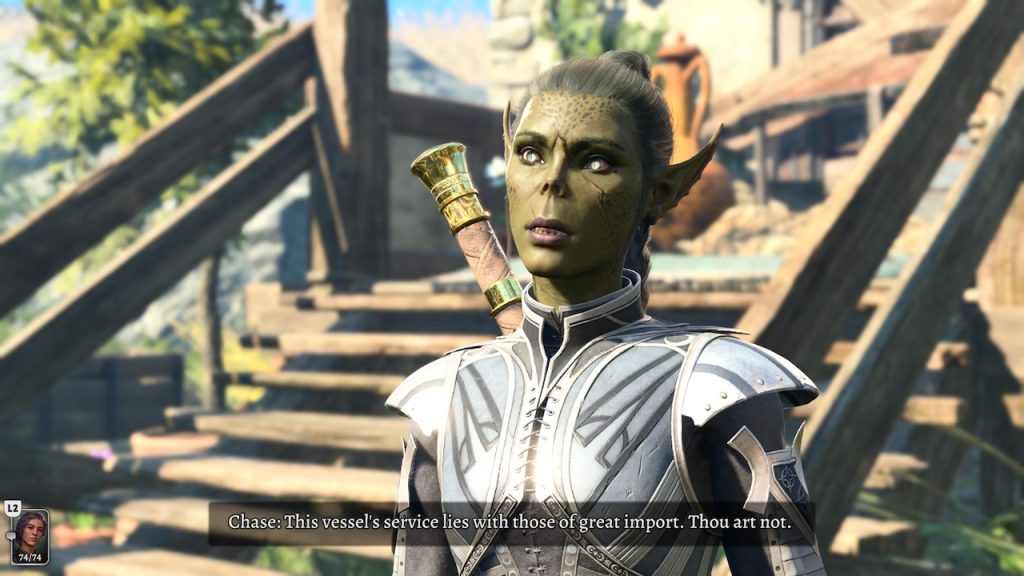
They are named after a friend of mine: Sabrina Marie Chase. She’s an experienced teacher, life coach, diviner, and writer. I’ve known her since 2002. If you feel that you need any of those services, I give her my highest recommendation.
I told Sabrina the story of what I’d done with Angela, Karma, and Wings in playthrough 8. I shared how Arctic Druid Angela had become so significant a character in my mind that I wrote three pieces of fanfic about her.
Real Angela had only a passing interest in the adventures of Druid Angela. Real Sabrina was enthusiastic about the possibility of the same thing happening with Sorcerer Sabrina.
Among other things, Real Sabrina is an anthropologist. She said that the process by which Arctic Druid Angela became “real” for me was akin to creating a spirit helper. She predicted that even though the story of Arctic Druid Angela was over, her spirit might continue to exist and have some influence.
I’m Wiccan. I’m familiar with the concept of spirit creation based on a living person, and recognized that this could happen with a fictional character as well. (Who’s more “real” in the cultural zeitgeist, Henry Cavill or Superman?) This is similar to the creation of a lwa in Santería.
The story of Arctic Druid Angela had little to do with Wyll, the Avatar for playthrough 8. The story of Sorcerer Sabrina was closely tied to character arc of Laurelin. So I’m going to save Sorcerer Sabrina’s story until I start Laurelin’s.

Sorcerer Sabrina
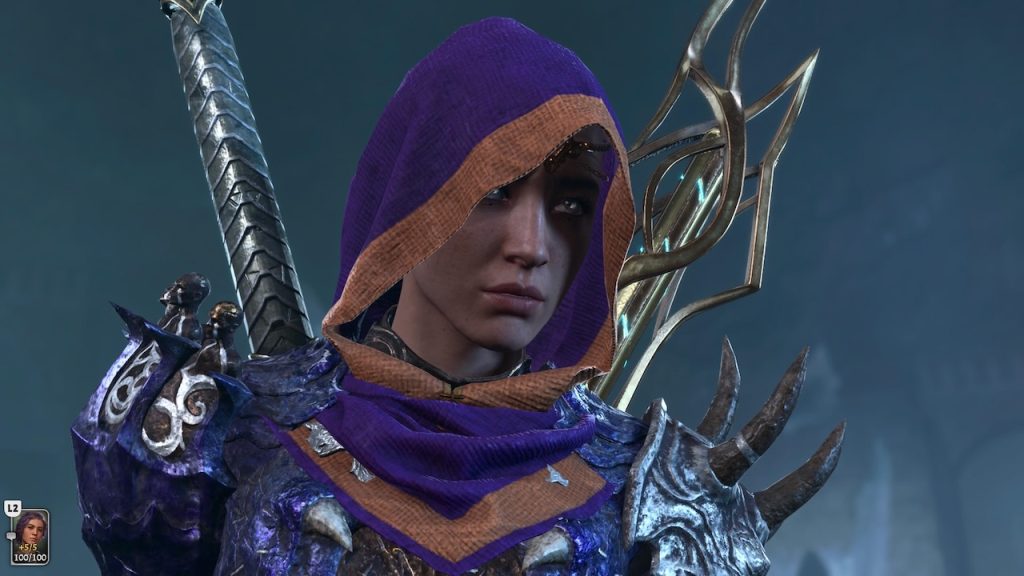
There will be no Sorcerer Sabrina fanfic, at least not in this blog. Real Sabrina said she’d prefer to receive occasional pictures via text. So far Real Sabrina hasn’t had much time to pursue Sorcerer Sabrina’s story, so I haven’t gotten much feedback.
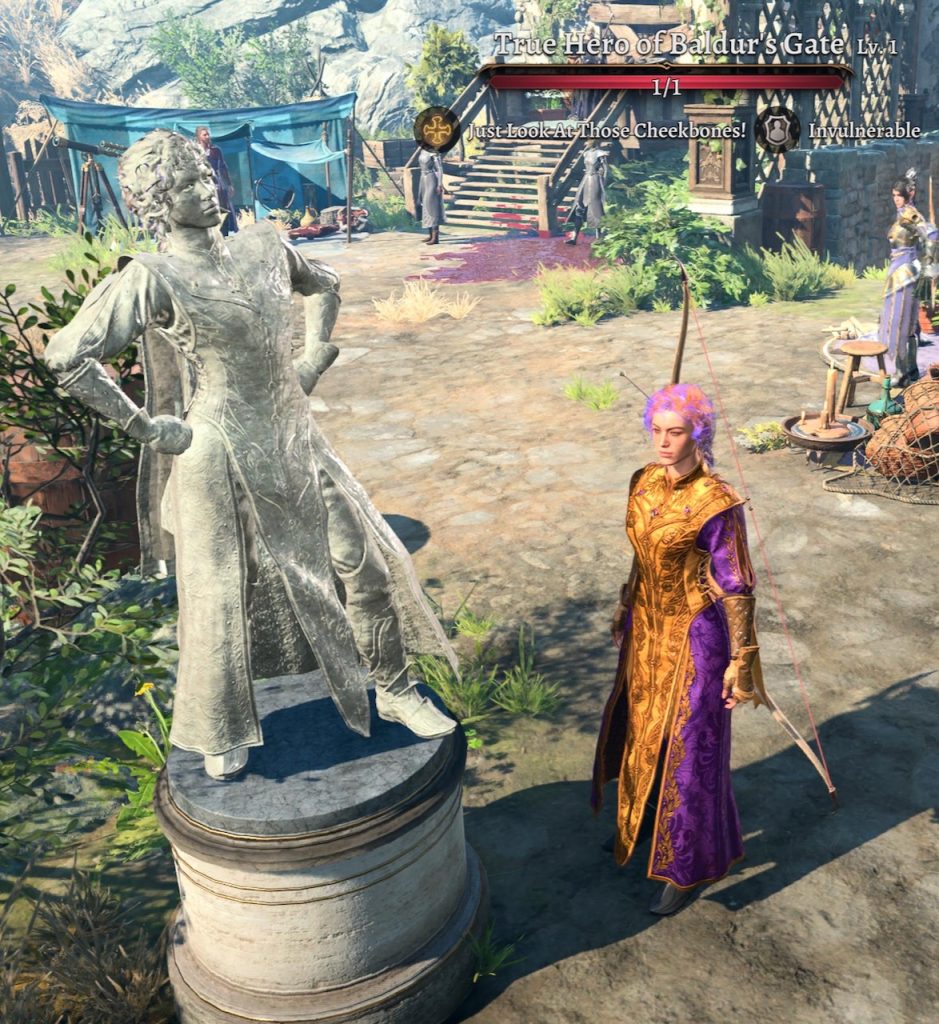
However, I must share this anecdote that illustrates the connection between real and fictional:
As I mentioned above, Laurelin was determined to pursue a relationship Astarion. The two of them agreed to get together after a party.

Lae’zel was disappointed with Laurelin’s choice.
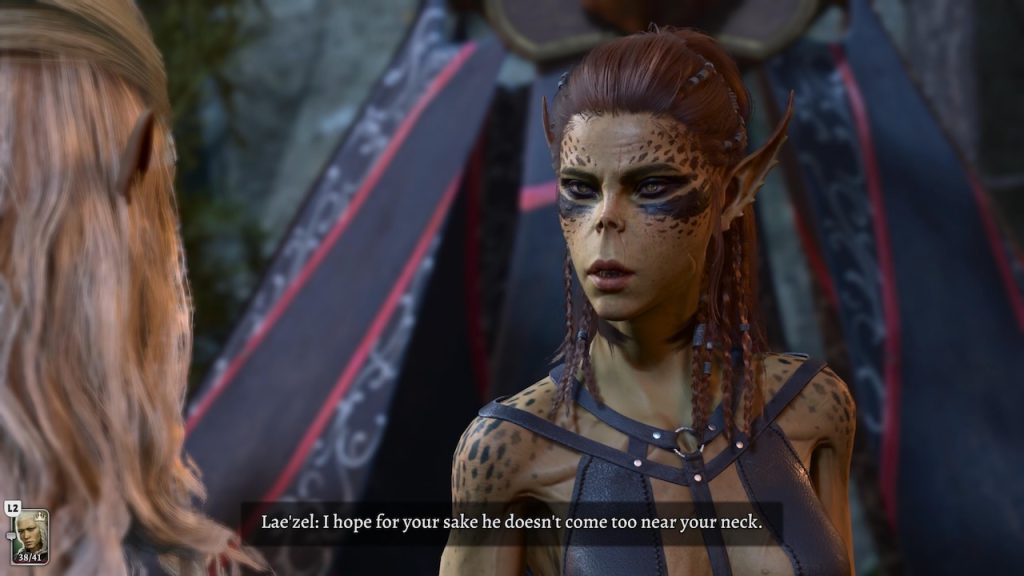


At that same party, I decided to have Sorcerer Sabrina speak with Lae’zel. To my surprise, Lae’zel hit on her:
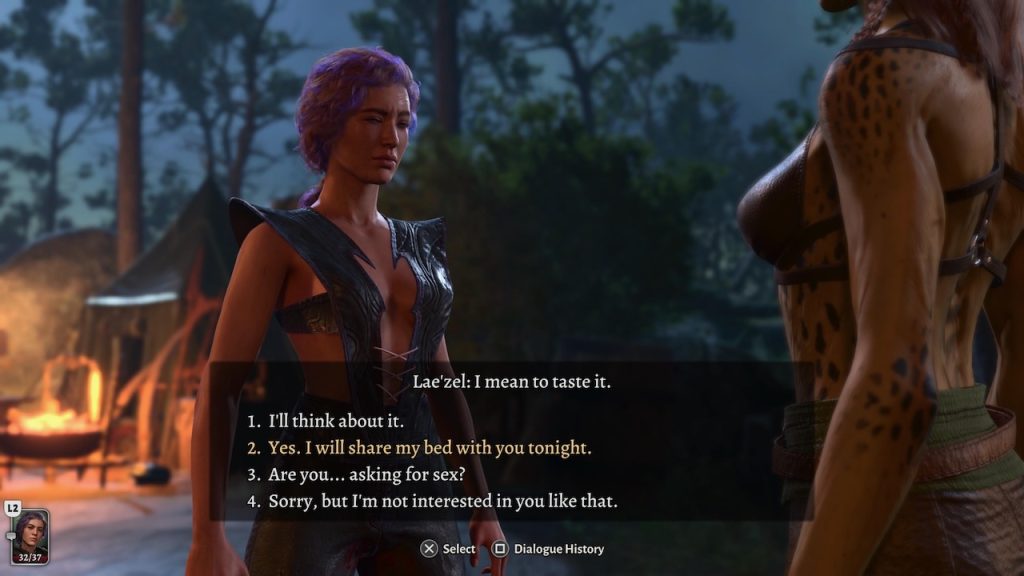
I told Real Sabrina this story. She responded, “I think I’d say to her that I’m not ready for this yet…” and started going over reasons.
I didn’t have the heart to tell her that this sequence occurred a week before I spoke with her, or that it wasn’t possible to give that response within the game.
What fascinated me: Real Sabrina has absolutely no interest in playing BG3; she’s not a video gamer. The only connection she has to Sorcerer Sabrina is that they have the same name. Within the context of the game, Sorcerer Sabrina is a Hireling with no story or free will of her own.
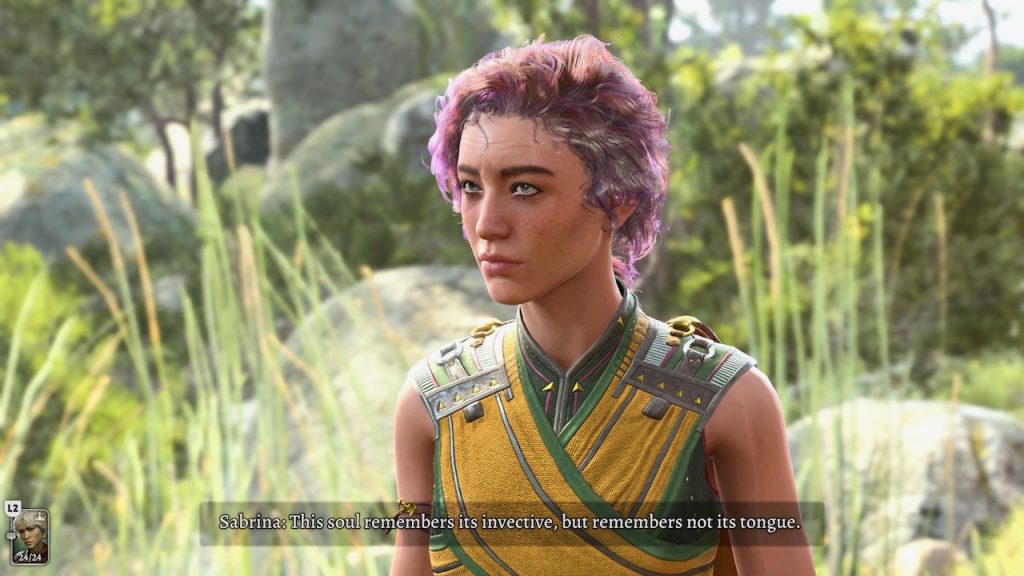
Yet Real Sabrina couldn’t help but identify with this digital creation. It’s a natural and human thing to do.
This normalizes my experience of obsessing over Arctic Druid Angela. The spirit of Sorcerer Sabrina exists!

It makes me wonder what the spirit of Arctic Druid Angela is doing right now. I should ask Real Angela if she’s felt any chills lately.
By the way, there was no consequence to Sorcerer Sabrina’s acceptance of Lae’zel’s invitation. I think that if an Origin character had asked Lae’zel instead, there would have been a line of dialog acknowledging Lae’zel’s second choice. I’ll pursue this in a subsequent playthrough.
Sorcerer Sabrina – System
In setting up the Three Protectors of Sabrina, Marie, and Chase, my original intention was to have Marie and Chase fulfill the Druid/Wizard+Cleric role that I’ve described before. Sabrina was going to be a Sorcerer to charge up the Drakethroat Glaive when I acquired it for another character. (For story reasons, I never got the Drakethroat Glaive.)
When Real Sabrina asked for Sorcerer Sabrina’s participation in the story, I decided to use this Storm Sorcerer build. I’d previously tried a Storm Sorcerer build, but it had not been successful.
This time, the build worked spectacularly.

At the earlier levels, I used the Blue Draconic Ancestry. As the game progressed, I switched to the Storm Sorcerery sub-class, which I felt performed better.
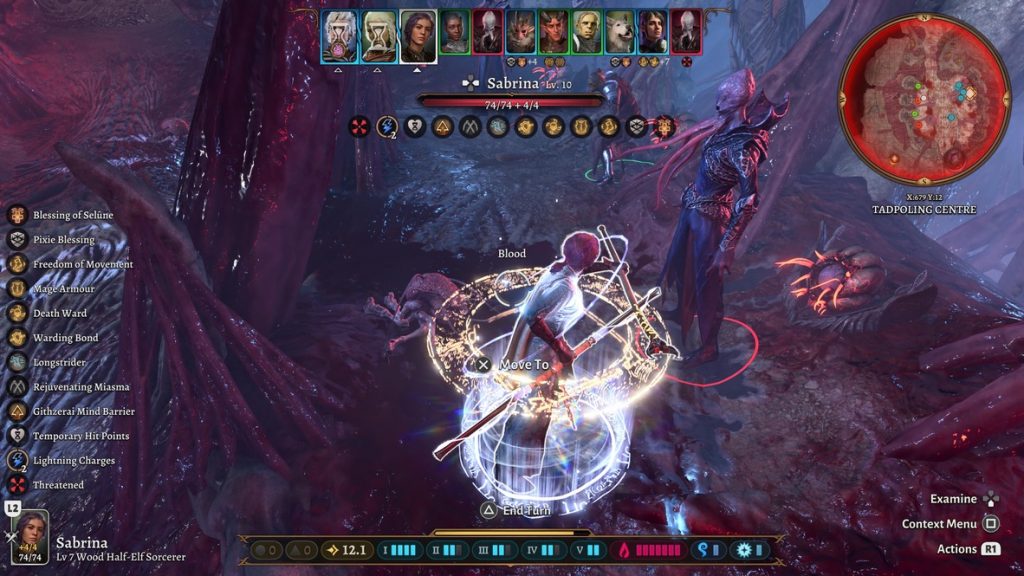
What made the difference in this playthrough is that I finally got the handle of how to use Call Lightning. It became Sorcerer Sabrina’s “bread-and-butter” spell. If she managed to cast Create Water before combat, she could set up large surfaces of Electrified Water to Electrocute enemies.
The problem with that strategy is that water surfaces apply the Wet condition, which makes enemies Resistant to Fire. This reduced Karlach’s effectiveness in combat. I had to balance the combat benefits of the two characters.
Verdict: Powerful build, would definitely play again.
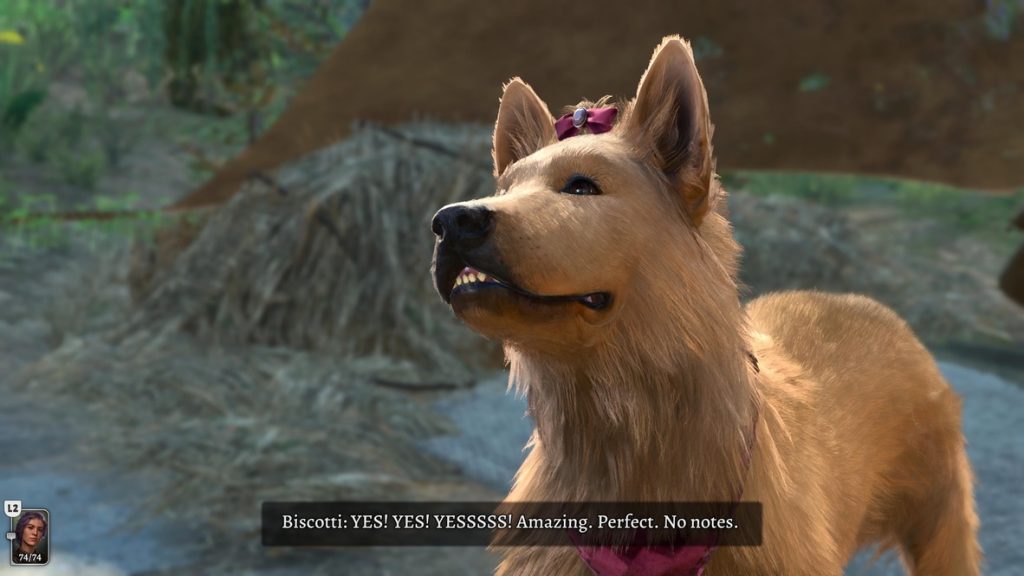
Laurelin
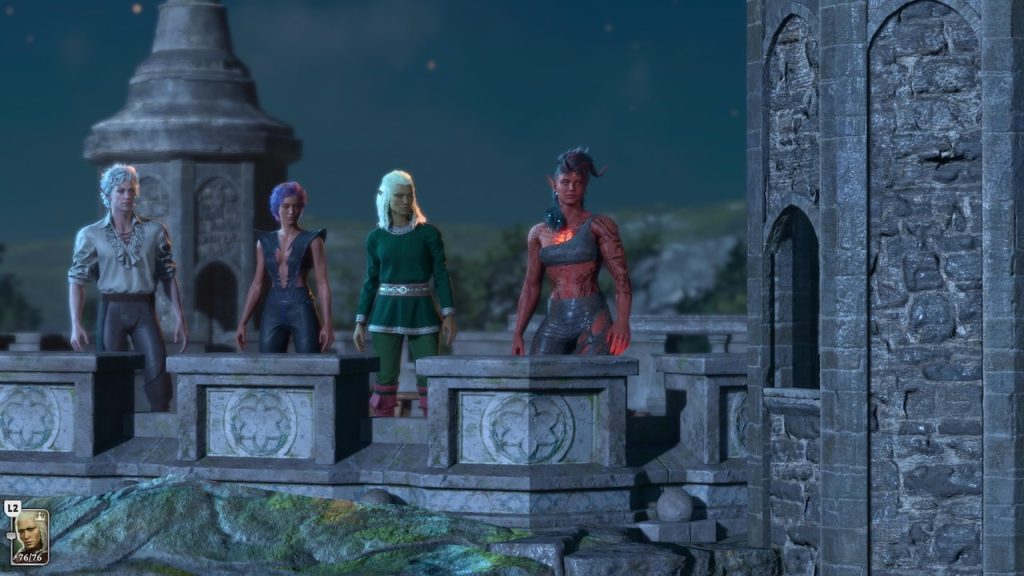
At last we get to the central character in the party, Laurelin.
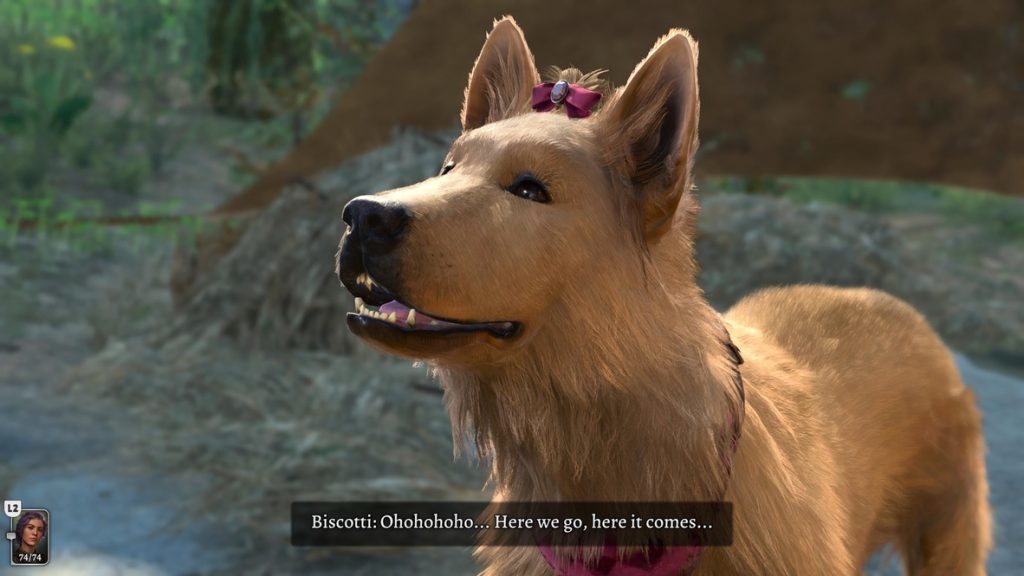
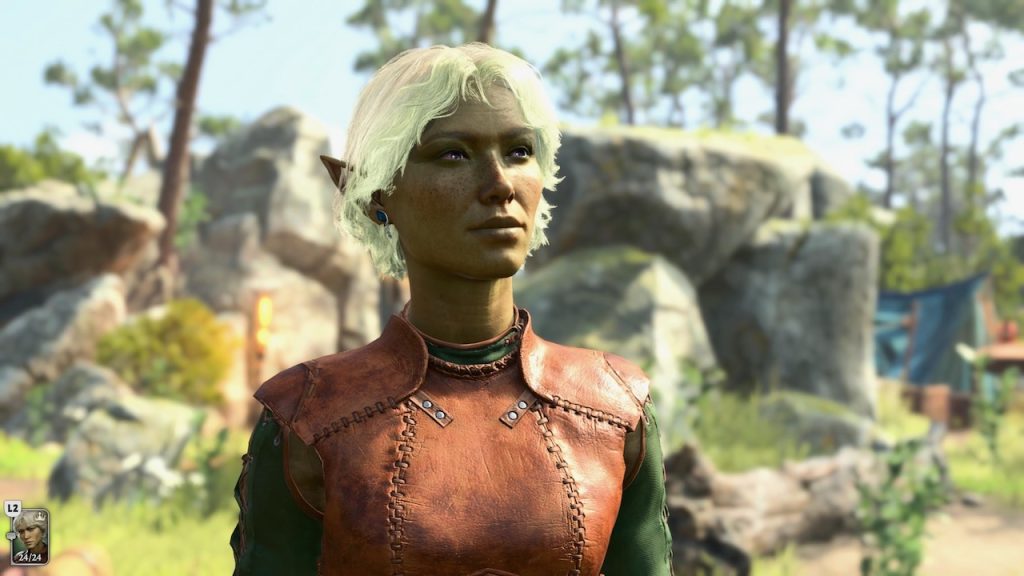
Laurelin’s game- and story-related aspects are closely linked in this playthrough. I’ll try to separate them, but I make no promises.
Laurelin – System
When I started the playthrough, I intended to make Laurelin a pure College-of-Lore Bard:
By the time I reached Level 4, I’d become dissatisfied with the build. That might have been because a Lore Bard is effective as a support character; they help control the battlefield though they can’t do much damage. I usually don’t mind playing support characters, but (as I’ll detail below) things started going wrong for poor Laurelin.
I decided to switch to a more combat-effective combination: 2 Levels of Paladin, 10 Levels of College-of-Swords Bard (aka a “Bardadin“).
This worked well enough, although most of my combat strikes were Paladin Smites; there were few Sword Bard Blade Flourishes. It was much like my experience with Lae’zel as a Sorcadin in playthrough 8: not much Bard-, a lot of -adin.
Then, for story reasons, I decided that Laurelin would become an Oathbreaker Paladin. At first, I respecced her for 3 Levels of Paladin and 9 Levels of Sword Bard; this was because an Oathbreaker doesn’t get their first interesting skills (Control Undead and Dreadful Aspect) until Level 3.
Finally, after bonding with Astarion fully, Laurelin decided it was time to fully commit to being an Oathbreaker as well. She respecced for one last time to become a full-fledged 12-level Oathbreaker:
Verdict: Setting aside the story reasons for the switch, I found this to be a very effective build. As we’ll see, at the end of the game it was almost too effective. I’d definitely play this again.
Laurelin’s Story
Now we get to the meat of the playthrough. Though I did not plan it, it’s a tale of Laurelin’s gradual descent into evil.

I didn’t intend to play Laurelin as an “Evil” character, but as a snarky one. It gave me a chance to explore some dialog options that I had not picked in my previous playthroughs.
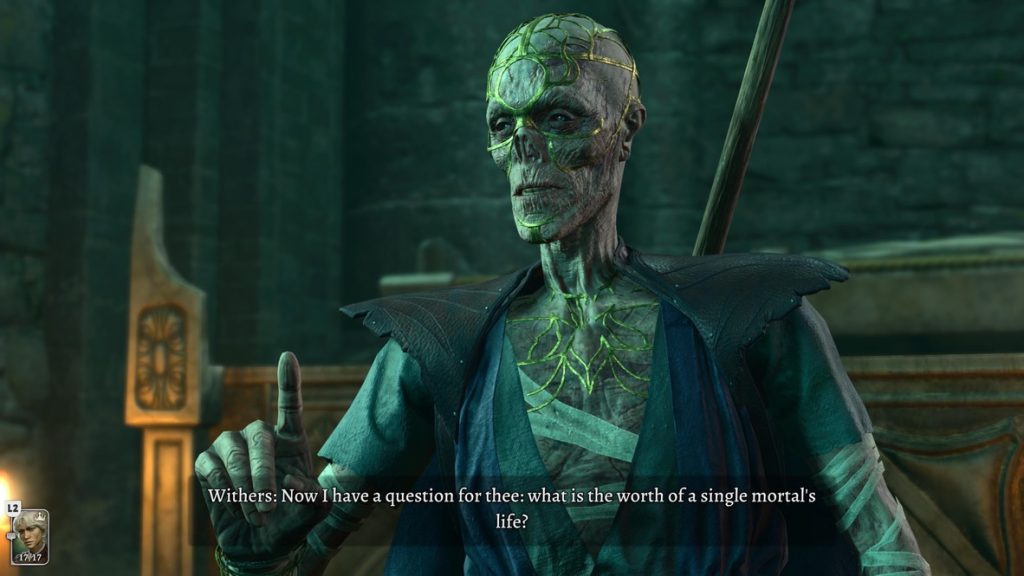

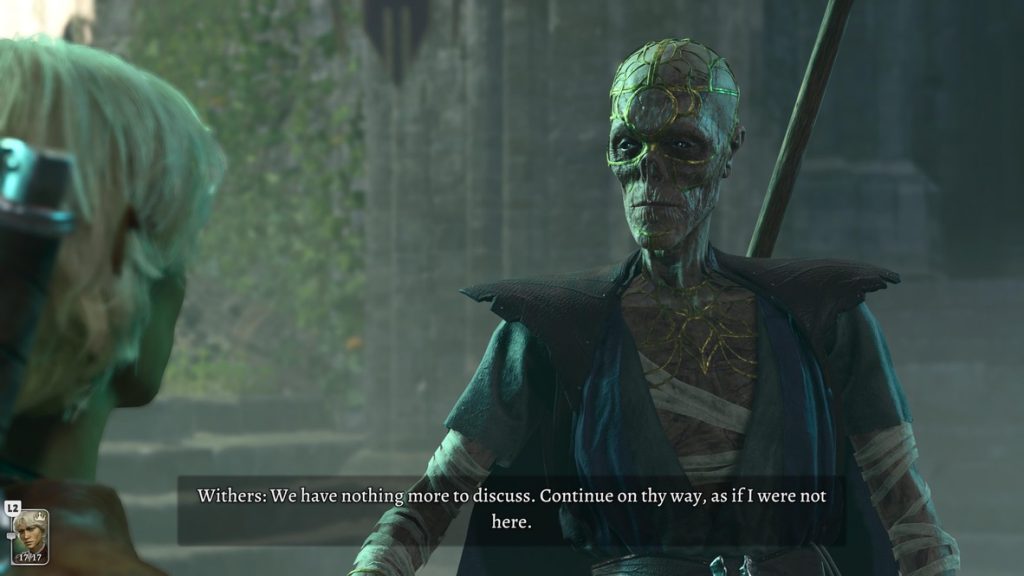
Astarion revealed that he was a vampire spawn. Laurelin was intrigued. She even volunteered to let him drink from her, so that none of the others in the camp would be at risk.

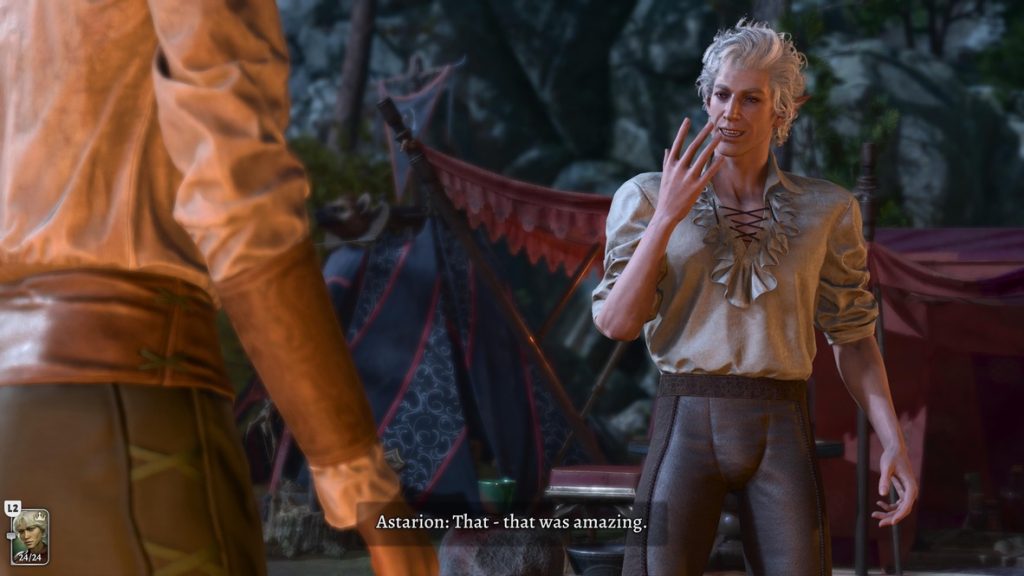
Then, in the refugee camp, Laurelin gave a snarky answer to a question that she should probably should have considered more. That single answer had consequences that reverberated through the game.
- The character who asked the question was not present to escort a group of refugee children.
- Those unguarded children were killed (off-screen).
- One of those children was a vendor who, later in the game, would sell items that Laurelin wanted to purchase.
- The guard who abandoned their duty survived until later, but they were bitter and gloomy when Laurelin met them again later in the game.
- The guard agreed that their boss was cruel. But when Laurelin killed their boss, the guard attacked Laurelin instead of siding with her.
- As a result, a valuable ally was not available in the final battle of the game.
It was not an evil moment, merely careless. But a single remark spelled doom for many.
At least Laurelin’s relationship with Astarion began well.
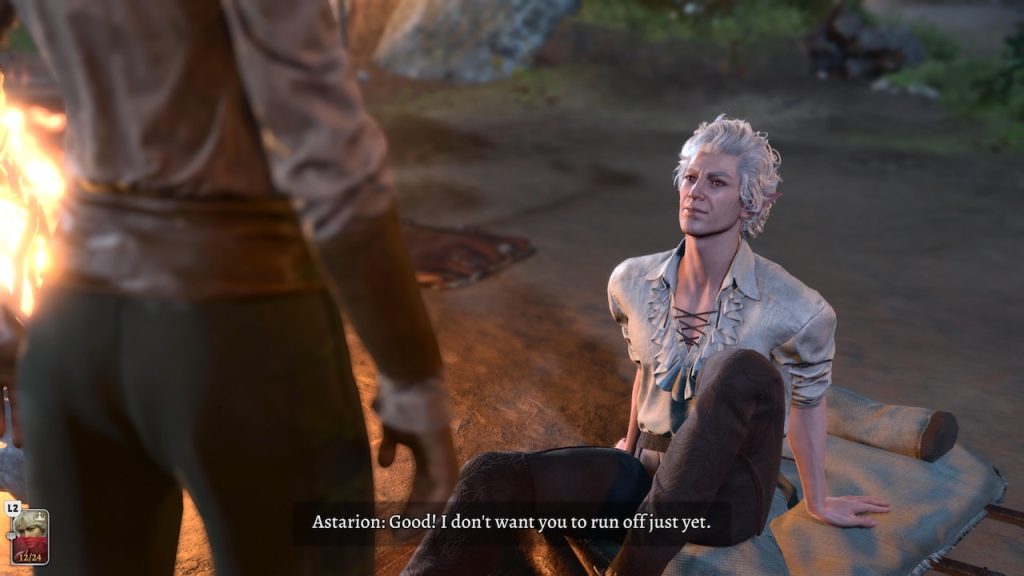
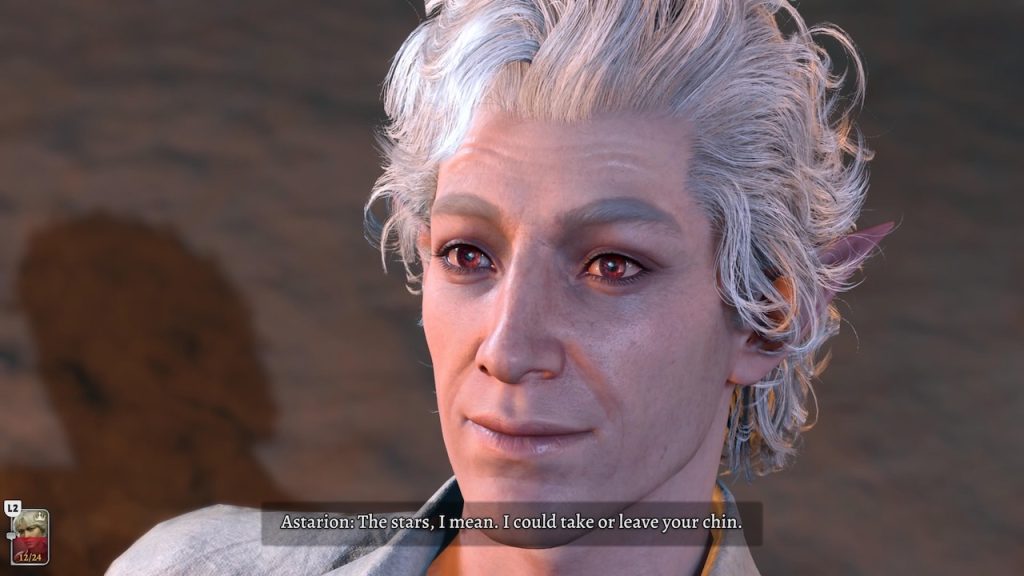
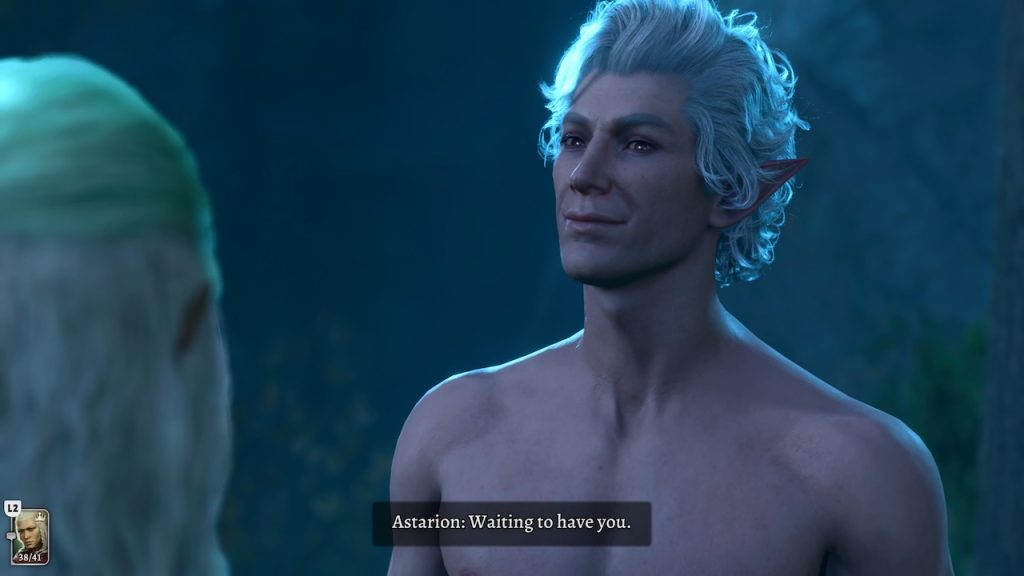
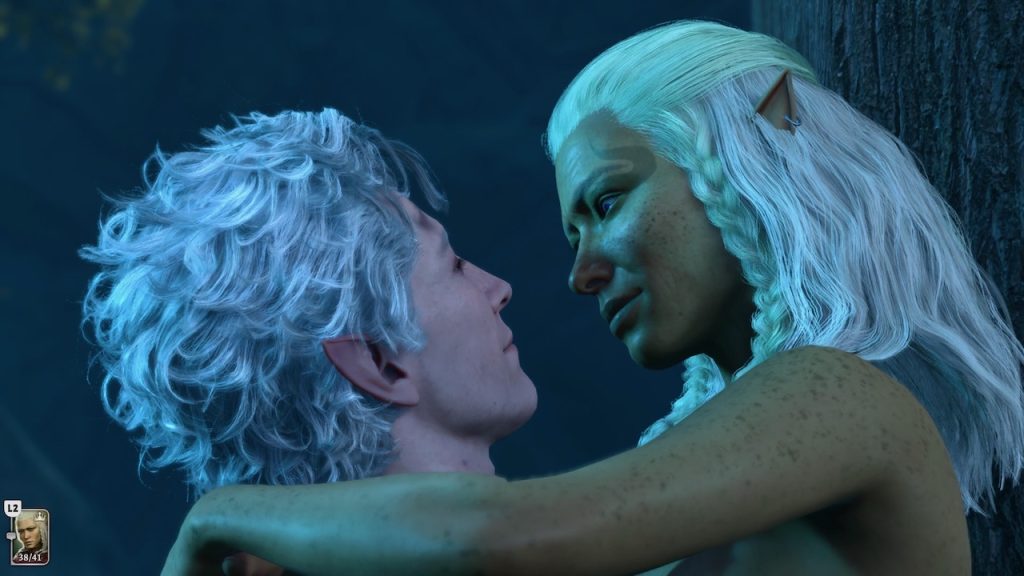


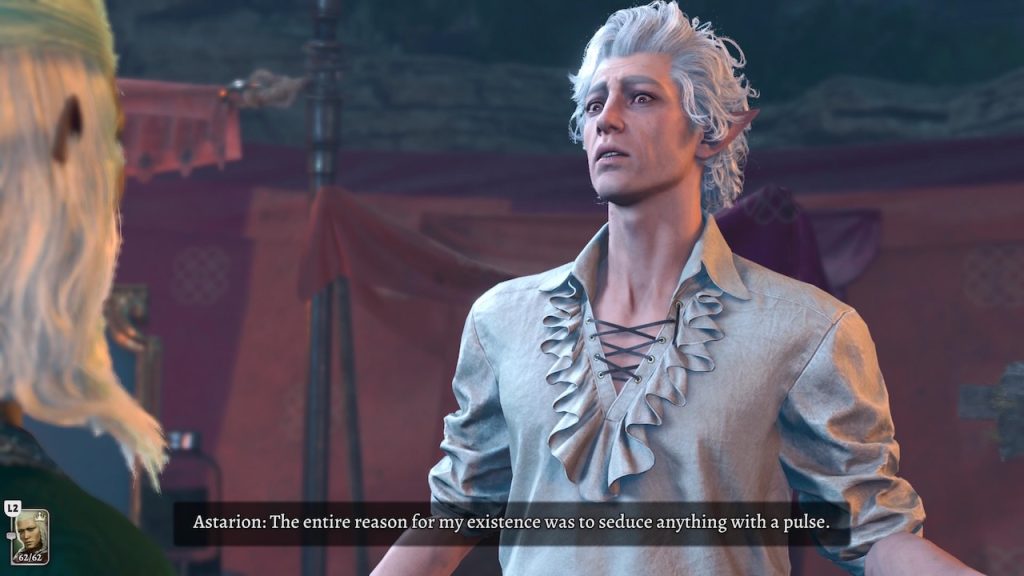
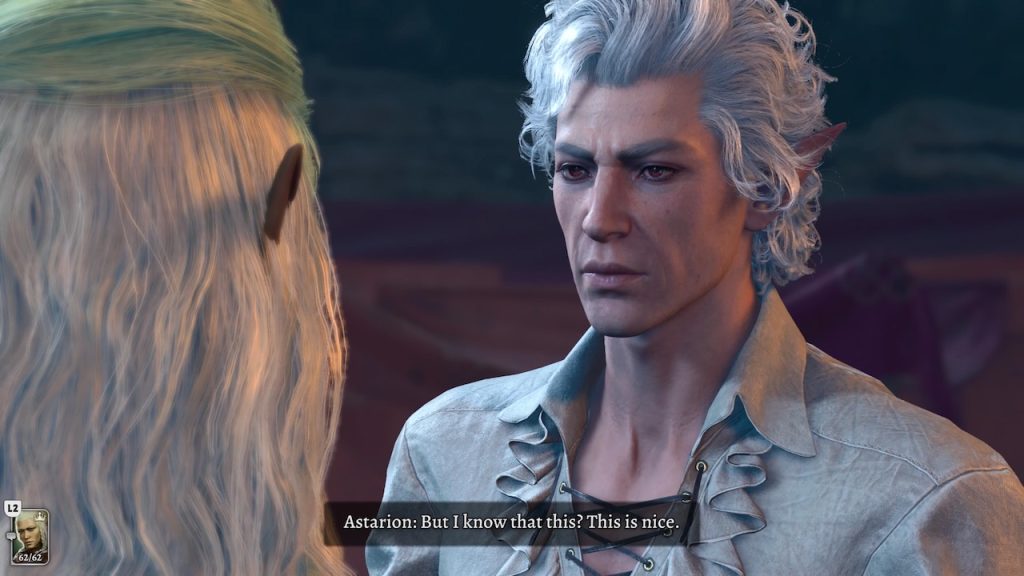
It all seemed so innocent. When it turned dark, was it Astarion who led Laurelin or the other way around? But that question came later.
There was a battle in the Goblin camp.

One of the nearby characters was a vendor from the Zhentarim mercenaries. That vendor had no real stake in the fight. Their usual behavior was to retreat from any unexpected battles.
Not this time. The vendor waded in and started casting spells that incapacitated the entire party. (Never before had I needed to use so many Scrolls of Revivify in a single combat.) Laurelin needed to defeat her immediately.
She did. She was not gentle about it. There are ways of “knocking out” an opponent, but that was not possible this time.
That vendor would have come back later, selling items that Laurelin and Sorcerer Sabrina needed. Now they were gone.
Once again, a simple act had gone awry, with consequences that would last for the rest of the game.
The party continued on their adventure. Eventually they came to a point where Shadowheart was called upon to make a choice.
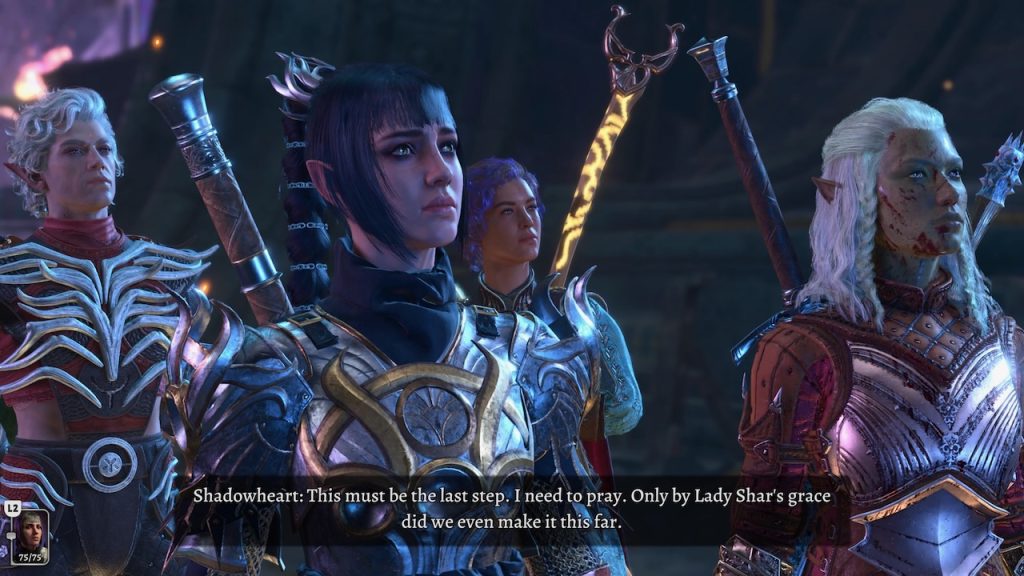
Laurelin had not really talked to Shadowheart before that point. Shadowheart had never accompanied Laurelin on an adventure. When the crux of the decision came, Laurelin did not try to persuade Shadowheart in a particular direction, but trusted her to use her judgement.
Shadowheart chose the darkness.

In seconds, a curse descended on the inn where the surviving refugees gathered. They were all transformed into shadow creatures, without hope of restoration or redemption. There was nothing left to do but slay the remnants of who they’d been.
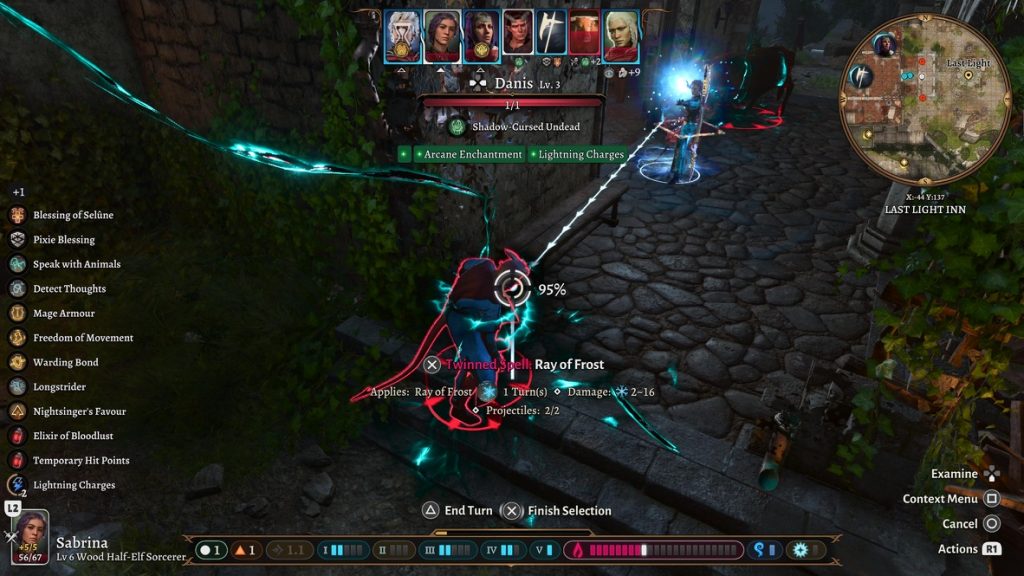
Once again, Laurelin’s good intentions had been twisted into something awful.
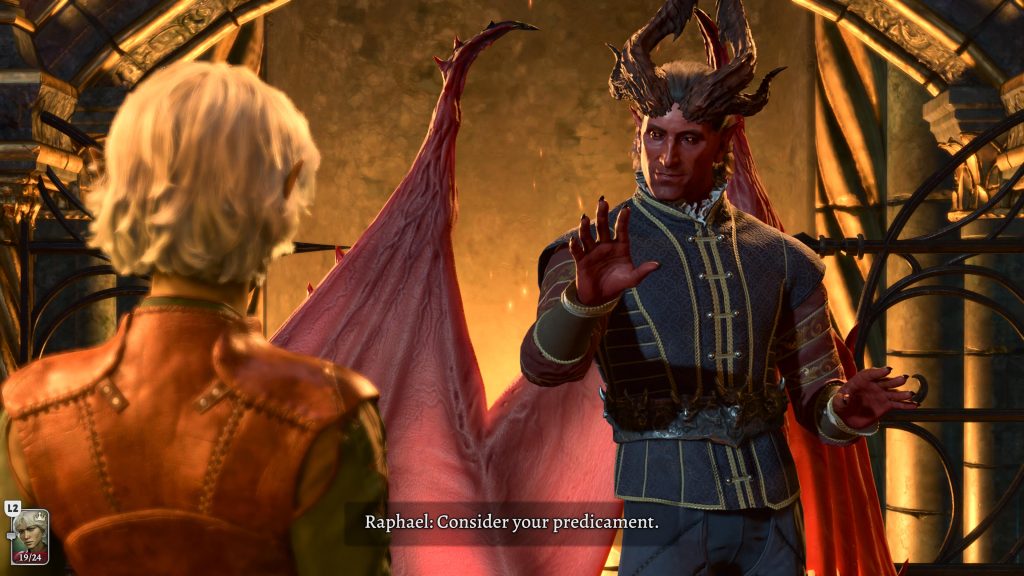
Later, Laurelin had to figure out how to balance the forces of her enemies. She chose to make agreements with both of them, thinking that an oath made to an malignant enemy did not count.
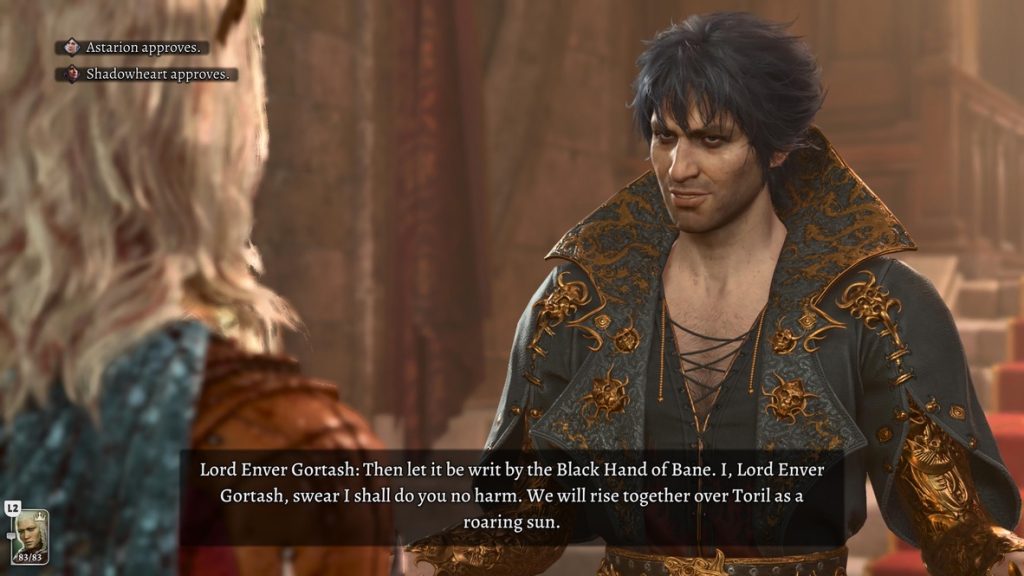
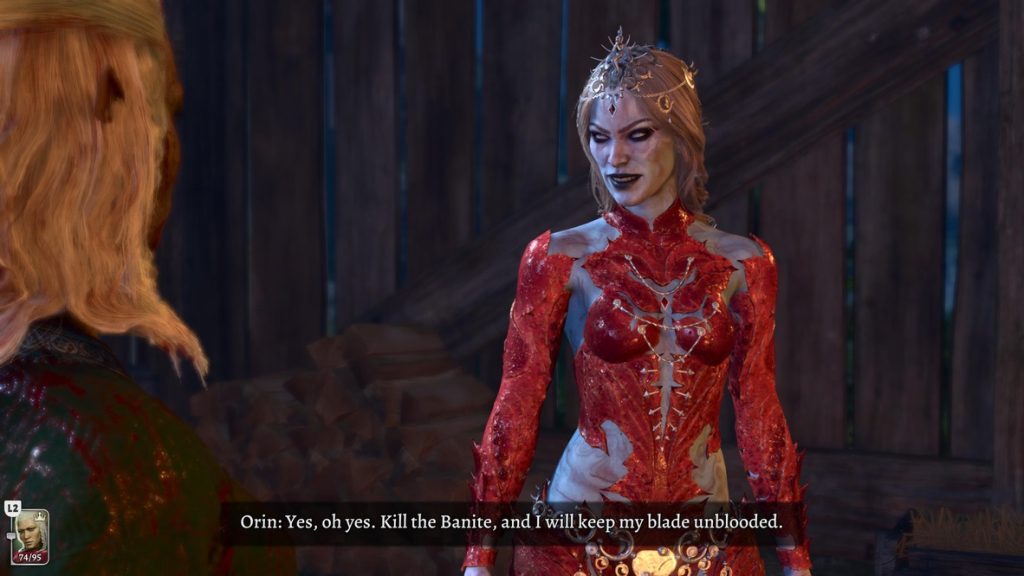
From a strategic standpoint, perhaps this was the wisest thing to do. But she’d forgotten the tenets of her Oath as a Paladin. By swearing oaths to evil forces, she’d broken an oath of her own.
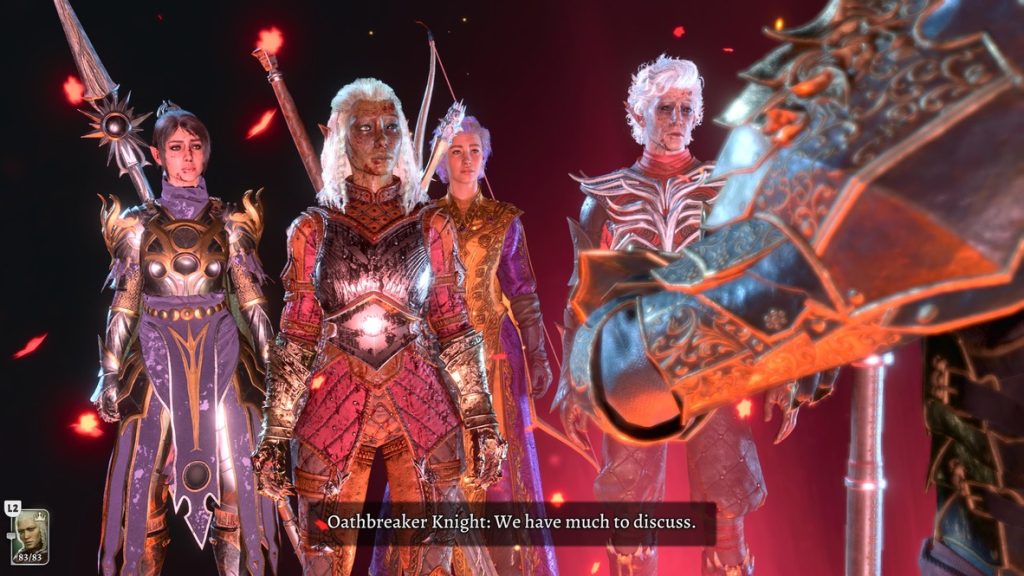
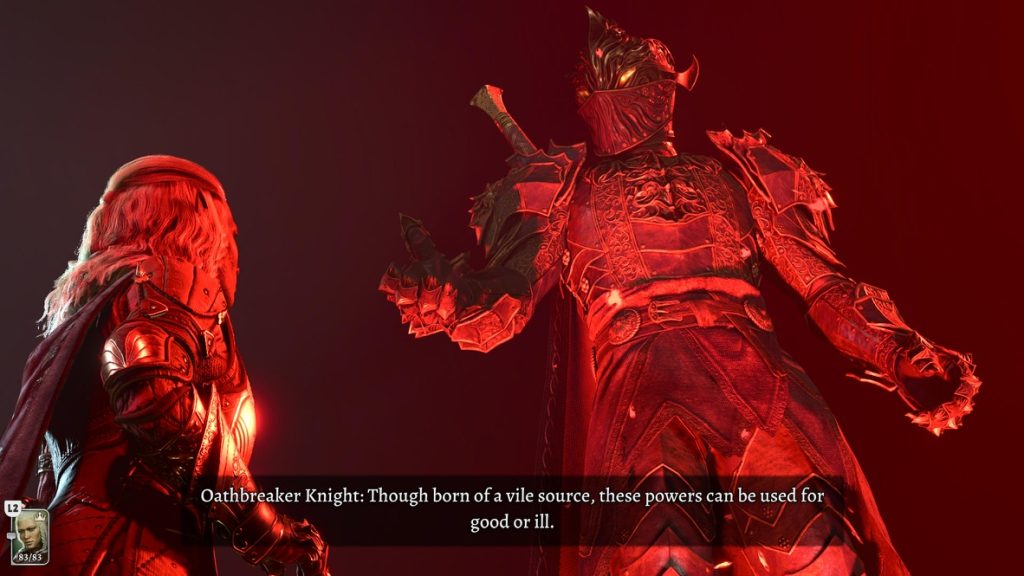
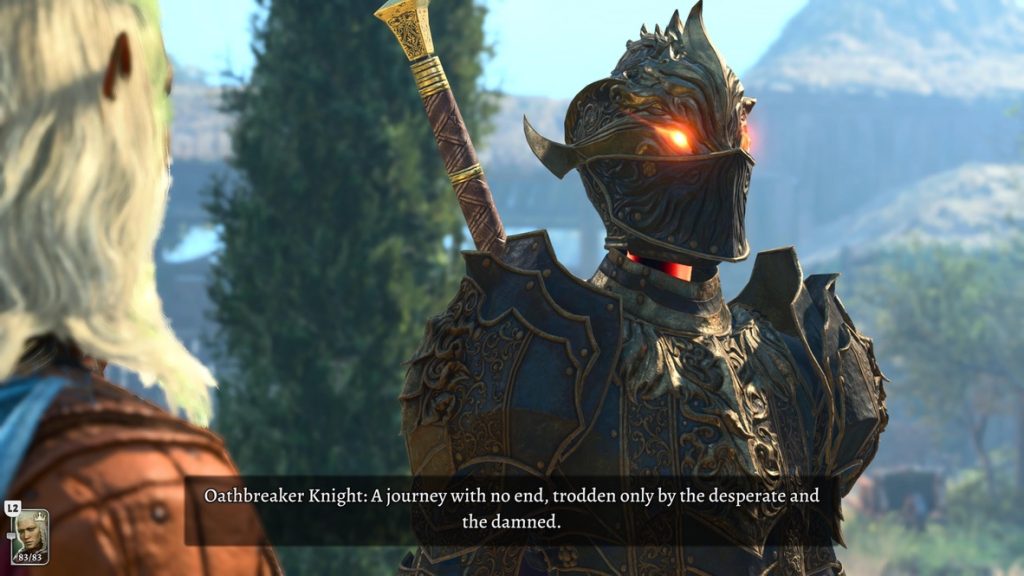
Laurelin looked into her soul and found no hope. When the devil Mizora propositioned her, Laurelin had no defense.
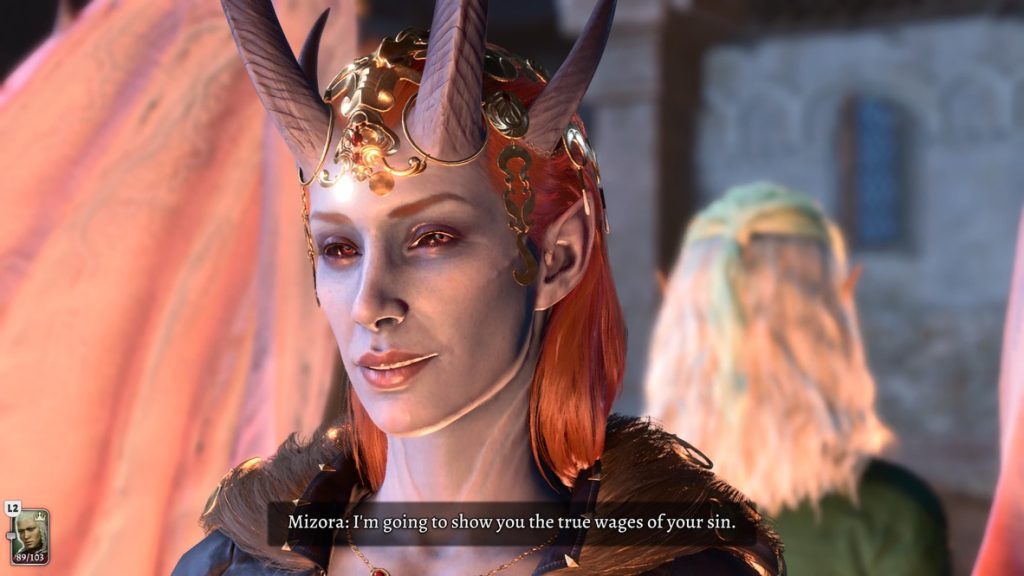
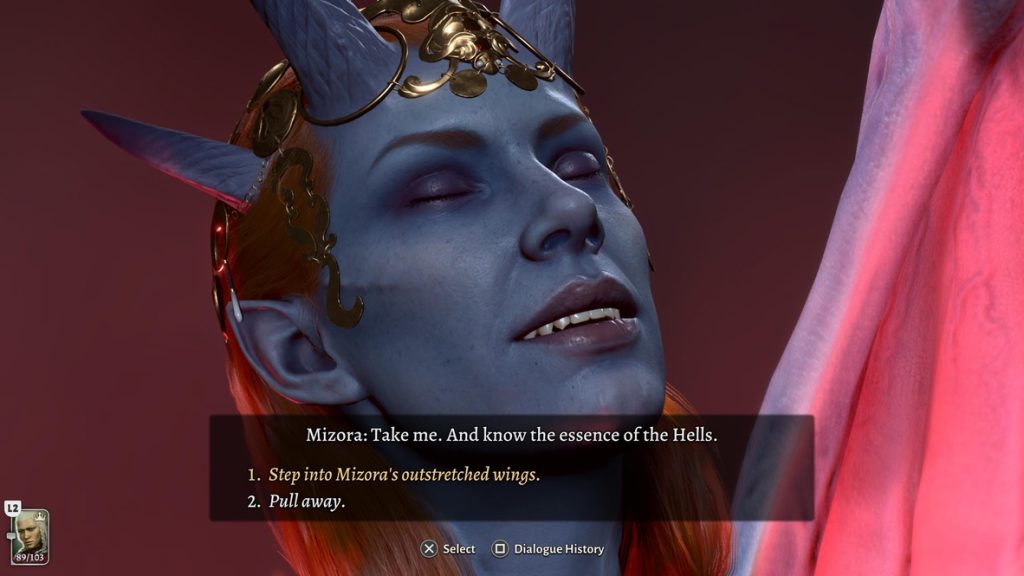

This didn’t bother Astarion at all.
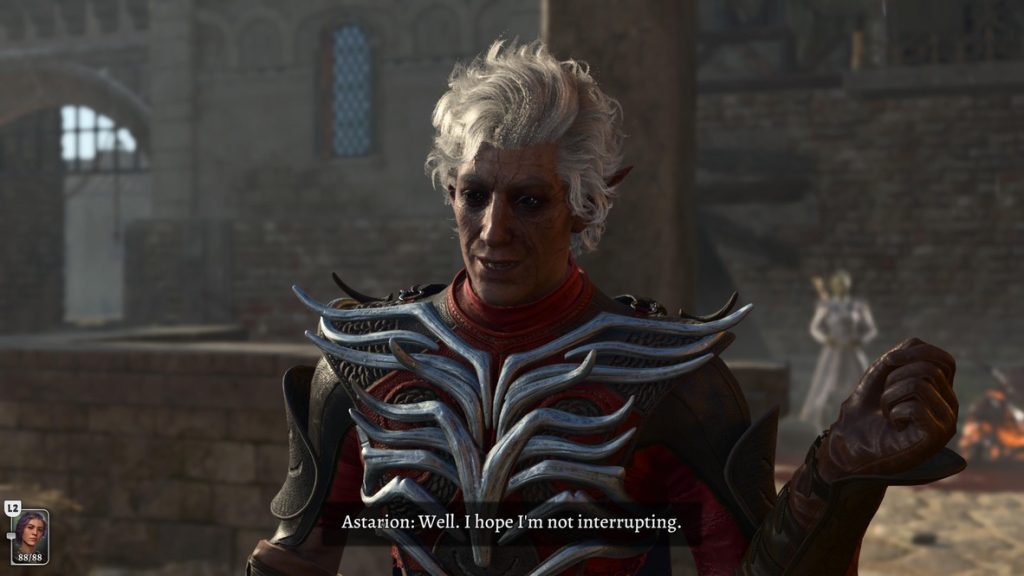
Later, Astarion had a choice of his own to make: to accept ultimate power at the cost of many lives, or to reject the temptation.
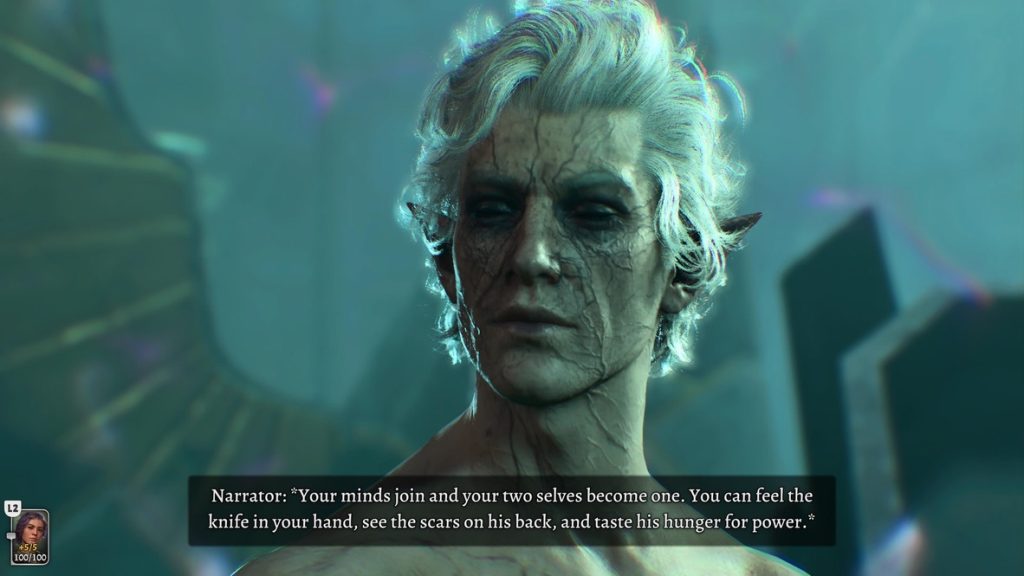
Laurelin told him to choose power.
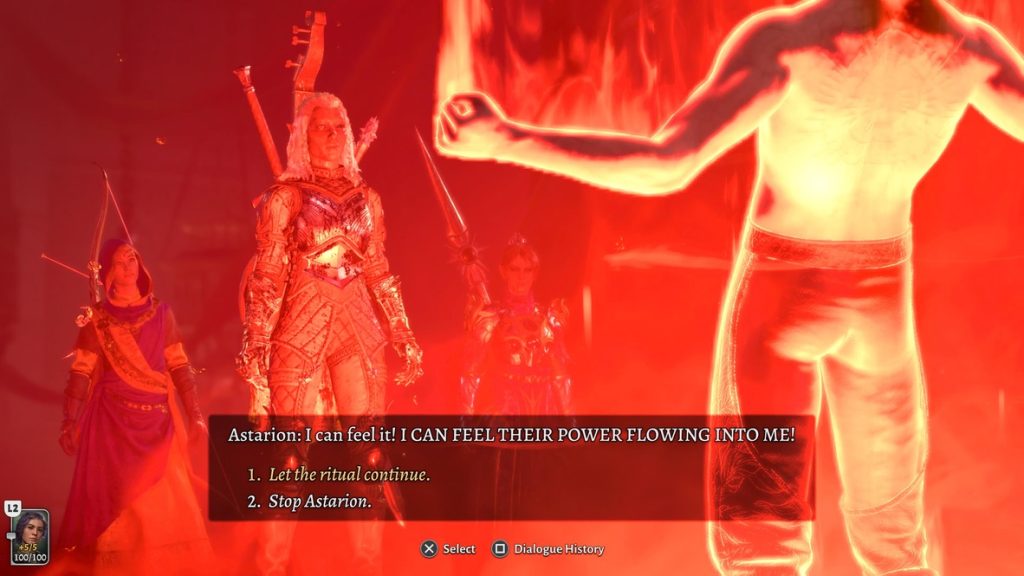
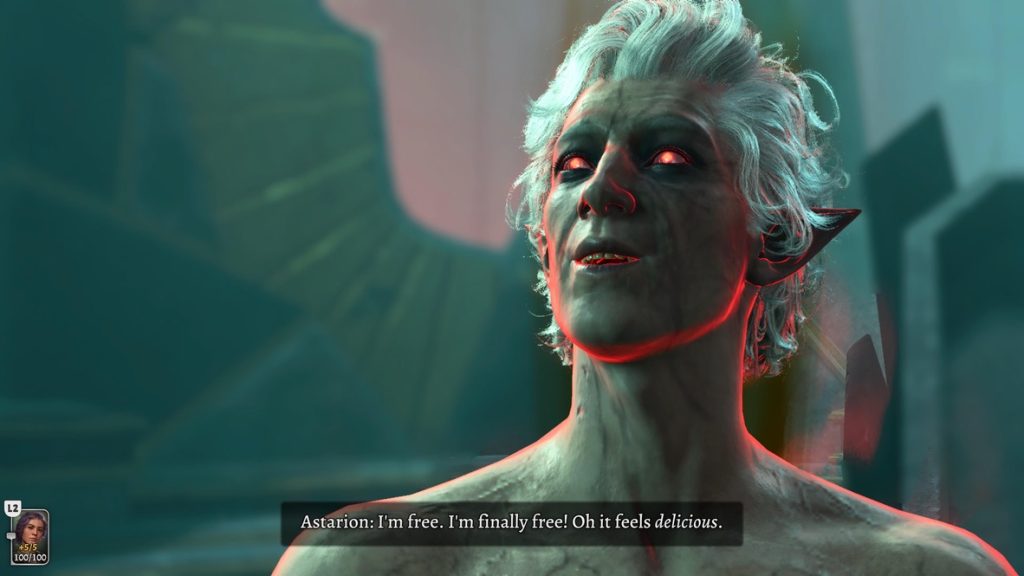
Astarion was now a Vampire Ascendant. There was but one more thing for Laurelin to do, one last act: To beg Astarion to make her his Vampire Spawn.
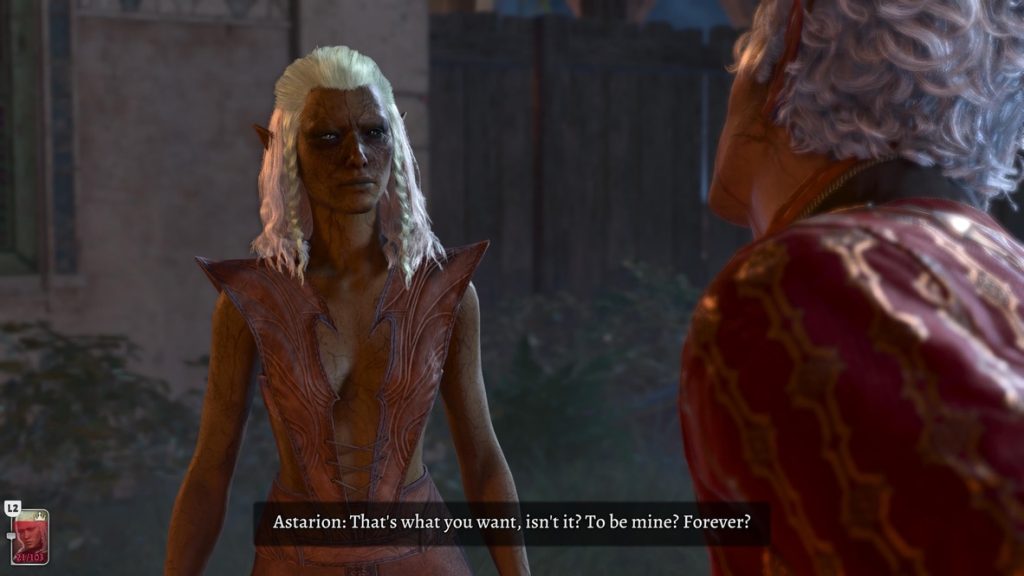



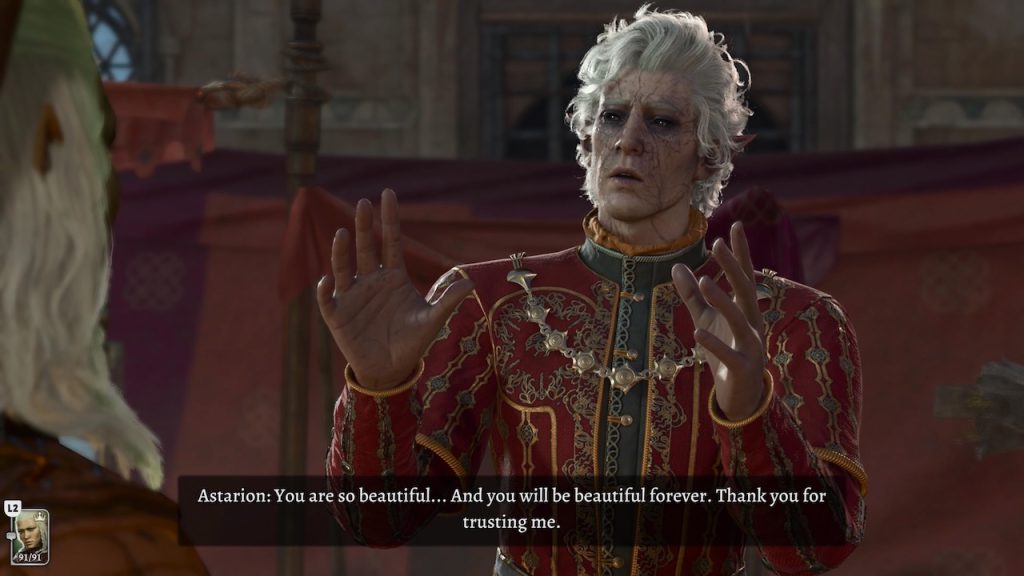
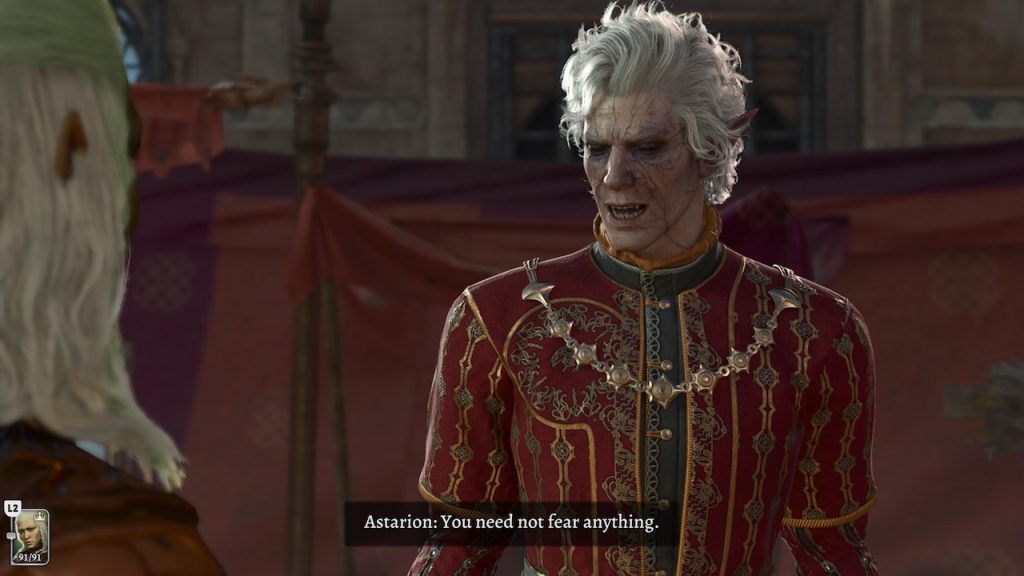
Was it to atone for her crimes, or because the quest for power had burned into her soul? She could not say, and now it did not matter.

What was Sorcerer Sabrina doing as Laurelin descended? She was trying to undo the damage done, and give counsel to Laurelin.

But that is Sorcerer Sabrina’s story. It’s reserved only for the ears that want to hear it.
A pause for understanding
At this point, there are some things I feel I should clarify. I have to drop the faux-narrative voice and get back to describing events from a real-world perspective.
When I described some of these events to Real Angela, she got confused. She got the impression that Astarion was a totally evil character; to enter into a relationship with him would mean descending as Laurelin had.
In the previous section, I didn’t distinguish between random game events and choices that I made as I proceeded with the story.
As I said before, I did not intend for this to be an Evil Playthrough. But as events unfolded, I decided that it would make sense for the story to evolve as it did.
After all, I’d gone through eight prior playthroughs in which I’d made only “good” choices for my characters, even when I played the Dark Urge. I felt it was time to explore a different path.
Those experienced with BG3 might point out that most of Laurelin’s misfortunes could have been corrected by restoring the game from a prior save. I decided not to do this. From a gameplay standpoint, I was doing well enough even without the items I could no longer purchase. As a story, something was happening. I thought it would be more interesting to explore it instead of continually revising it.
Astarion did not have to become a Vampire Ascendant. Again, this was a story choice I made.
As for Laurelin becoming a Vampire Spawn: This was another deliberate decision on my part. The game offered option after option that basically said “Are you sure?” It’s just one path on the game’s decision tree, not an inevitability.
Kissing
In my previous posts, I compared how the different Origin characters kiss: Minthara’s passion, Lae’zel’s hesitation, Karlach’s enthusiasm. I was looking forward to seeing how Larian approached Astarion’s kiss.
At first, I was disappointed. His kisses seemed generic.
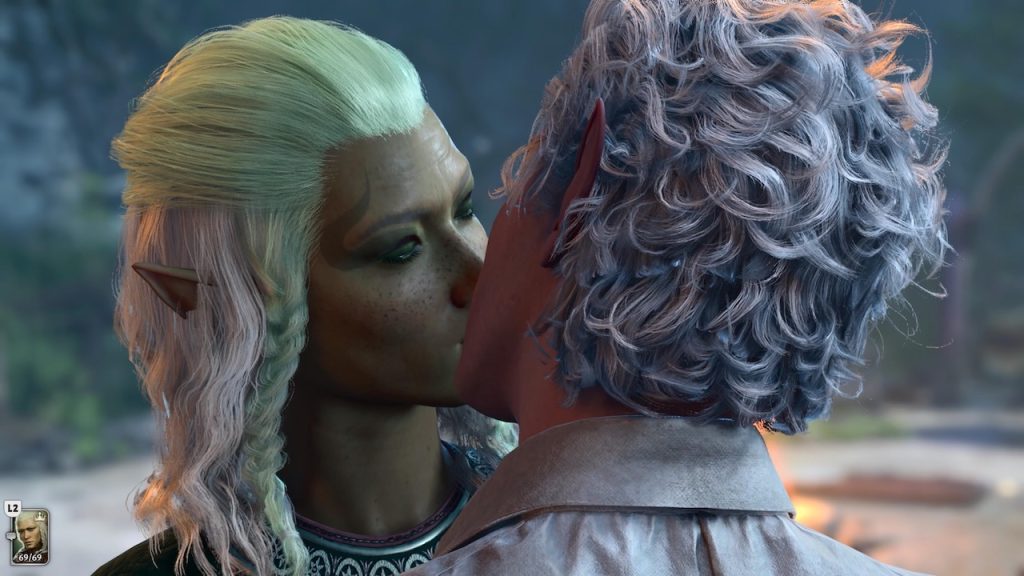
I planned to gripe about it when it came time to write this blog post.
Then I was reminded: Never underestimate Larian.
After Astarion became Vampire Ascendant and Laurelin his Vampire Spawn, the kisses completely changed to reflect their new relationship dynamic.
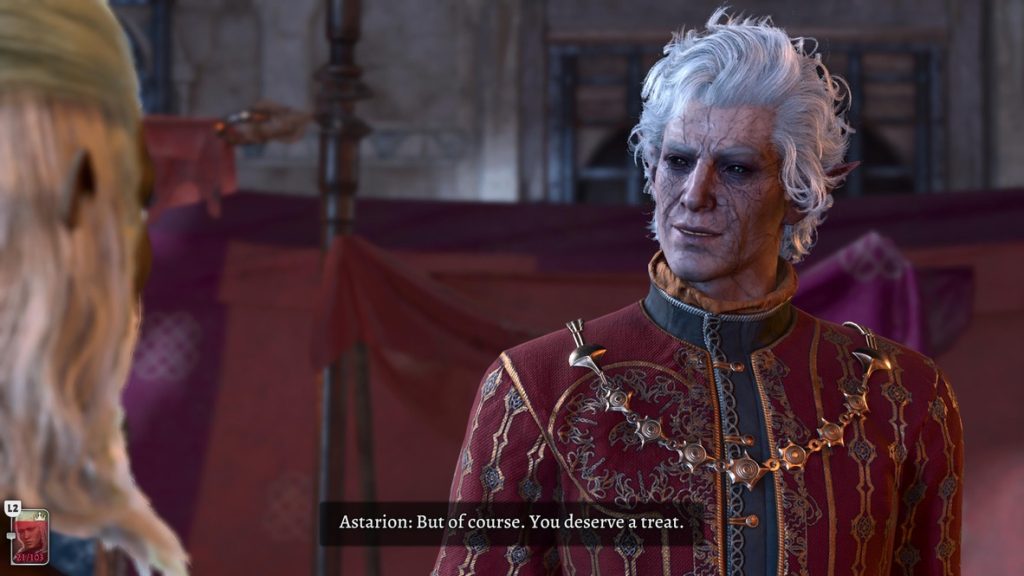
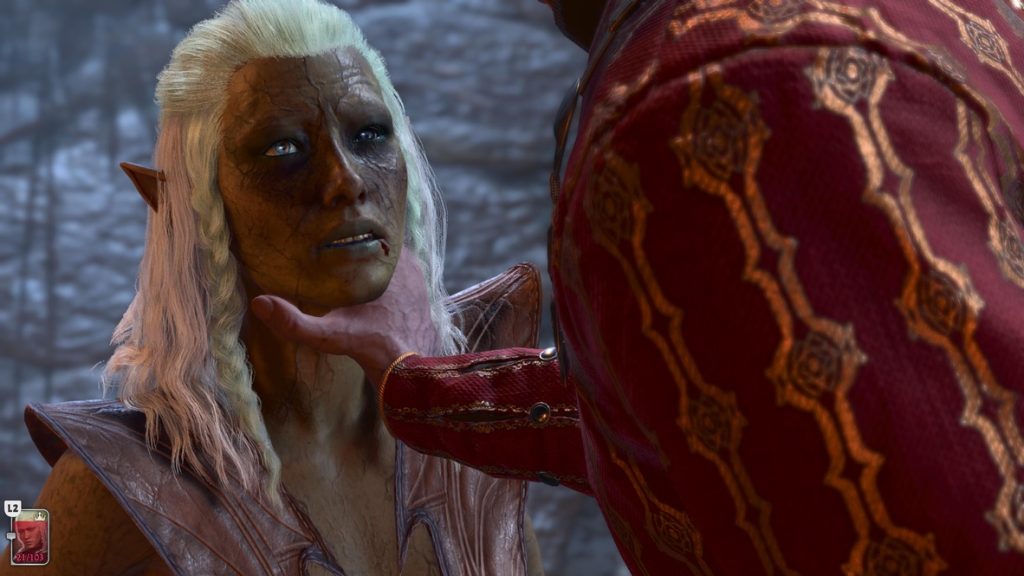
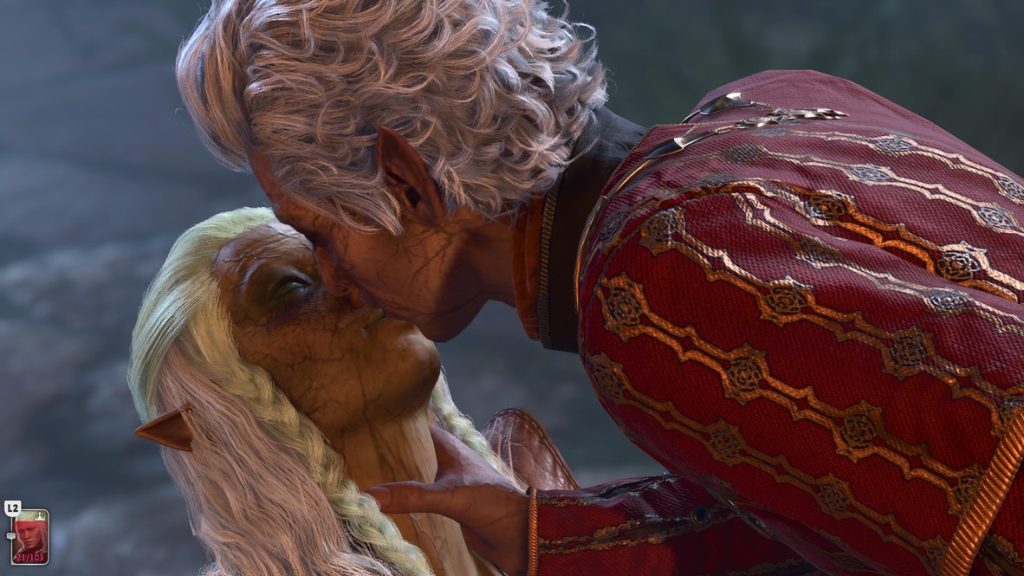
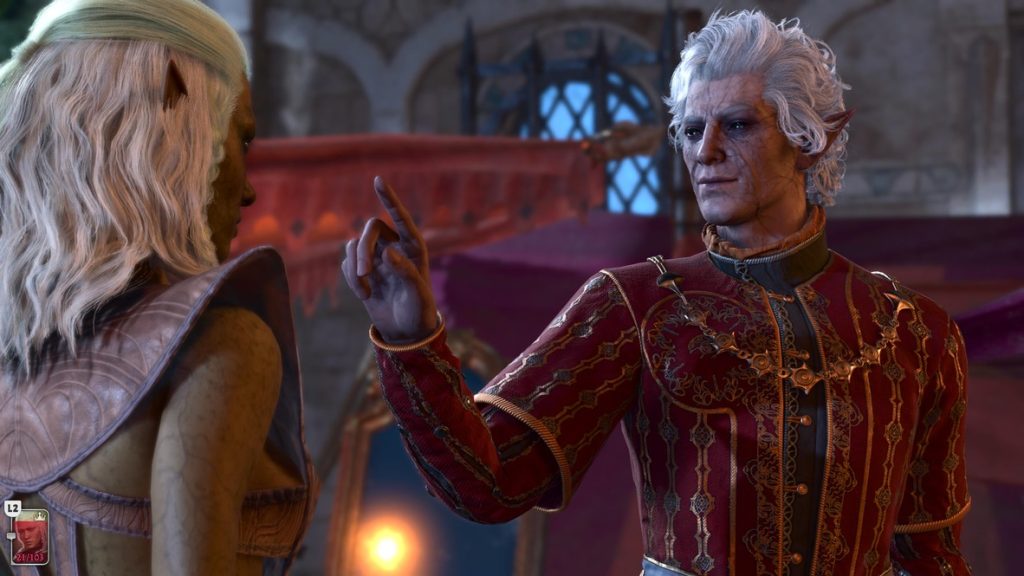
Perhaps someday I’ll revisit a relationship with Astarion to learn if his kiss changes after he chooses not to become a Vampire Lord.
More tales of a Hero Hireling?
The story of Sorcerer Sabrina belongs to Real Sabrina, if she wants it. As I said, I’m not planning to write Sorcerer Sabrina fanfic for this blog. The main reason is that it would heavily overlap the material I presented for Druid Angela. I’m relying on Real Sabrina being too busy to read Druid Angela’s story, so all of Sorcerer Sabrina’s story would be new to her.
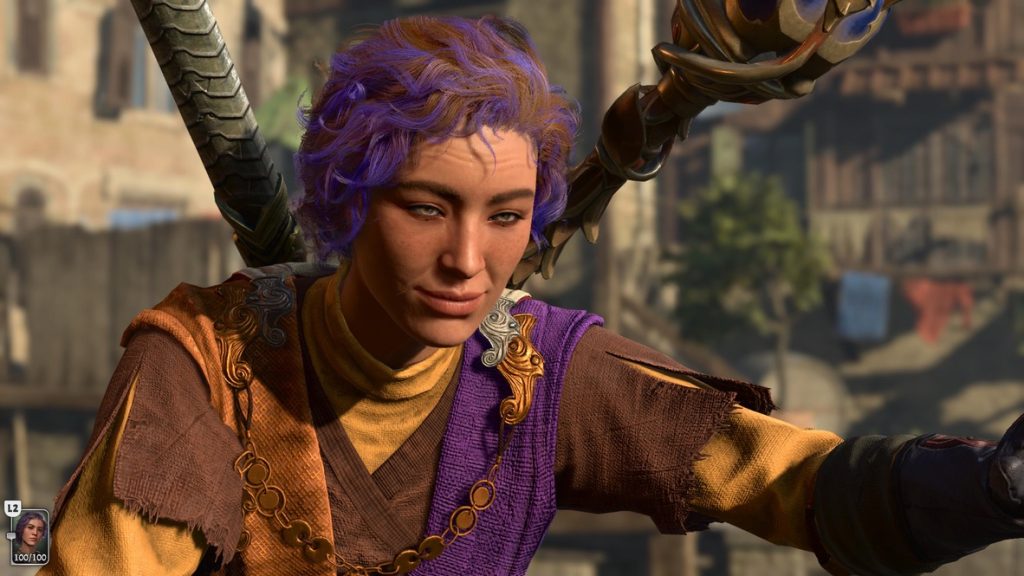
I mentioned that, in order to capture the screenshots for the Tale of Arctic Druid Angela, I had to jump through hoops to get images that had a Hireling taking action instead of the main Avatar character. For this playthrough it got even more complicated (as we’ll see below).
For playthrough 8, I took over 800 screenshots to tell the story. For this playthrough, number 9, I took over 1200 screenshots.

That’s more than enough.
I don’t mind taking the screenshots. It’s transferring them to my computer that’s tedious. It requires that I pay for a Playstation Network account, then use the Playstation App on my iPhone to copy the images to my Photos library. The Playstation App has many limitations; one of them is that it can only transfer four images at a time. It takes about ten seconds for each set of four.
It’s the perfect task for when I’m sitting in the bathroom.
The game is only designed to make the player’s Avatar have a centrol role. An attempt to place a different character in the forefront can easily fail. It becomes worse when you try to do this with a Hireling. The game denies them any form of agency.
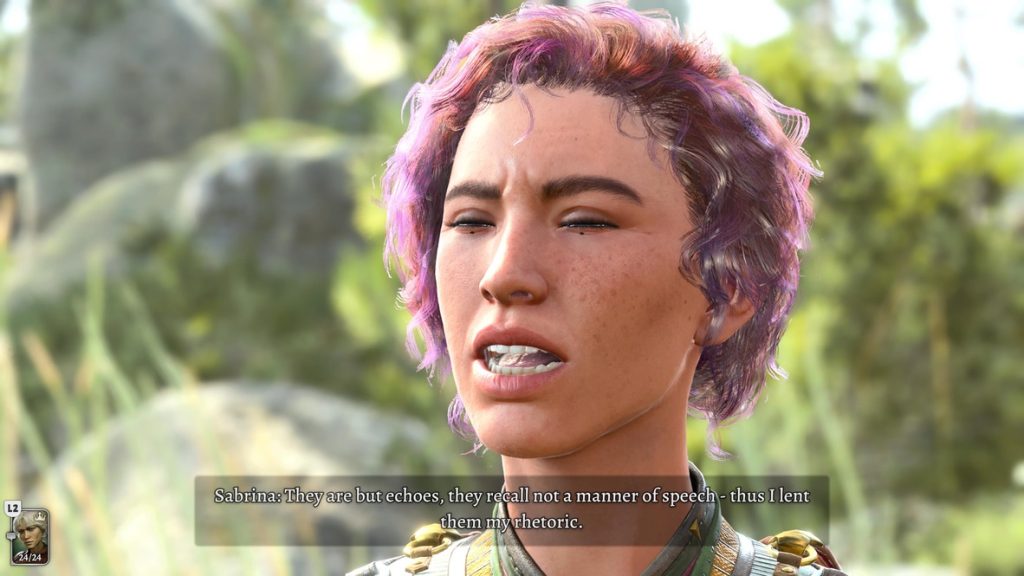
The main reason for the hundreds of screenshots is my attempt to capture an image with even a hint of the Hero Hireling.
A creative difficulty was that I was working through two stories at once: the descent of Laurelin and the heroics of Sorcerer Sabrina. This didn’t happen with Druid Angela, since Wyll was a known quantity to me; I could focus on a single protagonist. Here there were two.
What’s more, the stories didn’t quite mesh. If I were writing this as an independent tale, the Sorcerer Sabrina role would not be a “goody two-shoes”. She’d be Laurelin’s enabler, or her antagonist, or something of the sort. But I knew that would just upset Real Sabrina, who would not like to see her identity dragged down in this way. I did what I could; friendship triumphs over art.
If another friend of mine asks that I construct BG3 photo essays around a character with their name (the Tale of Michael the Monk!) I’ll start a new campaign with that character as the main Avatar.
It’s what I should have done with Sorcerer Sabrina. By the time Real Sabrina requested to hear her story, I was about a quarter-way through the playthrough. I fell into the sunk-cost fallacy, a pit from which one never escapes.
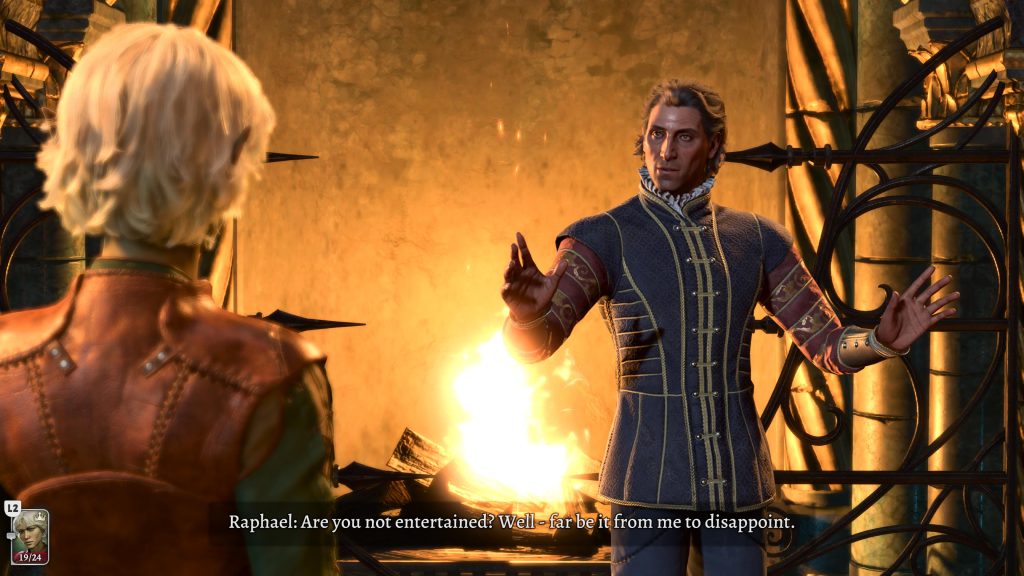
We’re nearly done with Laurelin’s story. However, I can’t continue as if it were an independent fiction. Perhaps it will give you some idea of how I interacted with the game as I tried to balance the game’s story with two protagonists.
The final confrontation
To wrap up the story of Sorcerer Sabrina, I wanted to do something that I could not do with Druid Angela: Capture screenshots of the Hero Hireling taking on the Ultimate Evil directly.
I tried.
There are two major face-to-face confrontations of the protagonist against the Ultimate Evil. For the first one, I left everyone else in the party, especially Laurelin, far behind. It didn’t work. Laurelin’s image appeared on the screen instead of Sorcerer Sabrina’s.
In the Druid Angela finale I made a clumsy excuse for this.
For the second confrontation, I went to extremes. I wanted Laurelin to die in the last battle, so the game would have no choice but to show an image of Sorcerer Sabrina.
How to “guarantee” that a character dies? Take off their armor. Laurelin would face a Dragon dressed in nothing but her underwear.
Remember when I said that an 12th-level Oathbreaker Paladin was too effective? This is why: Bikini-clad Laurelin was well on her way to defeating the Dragon without taking much damage.
I had her to use the Transfer Health power (give half your hit points to someone else; lucky Zevlor!) two times. This still wasn’t working.
Finally, I had to summon a Demon ally into the battle.
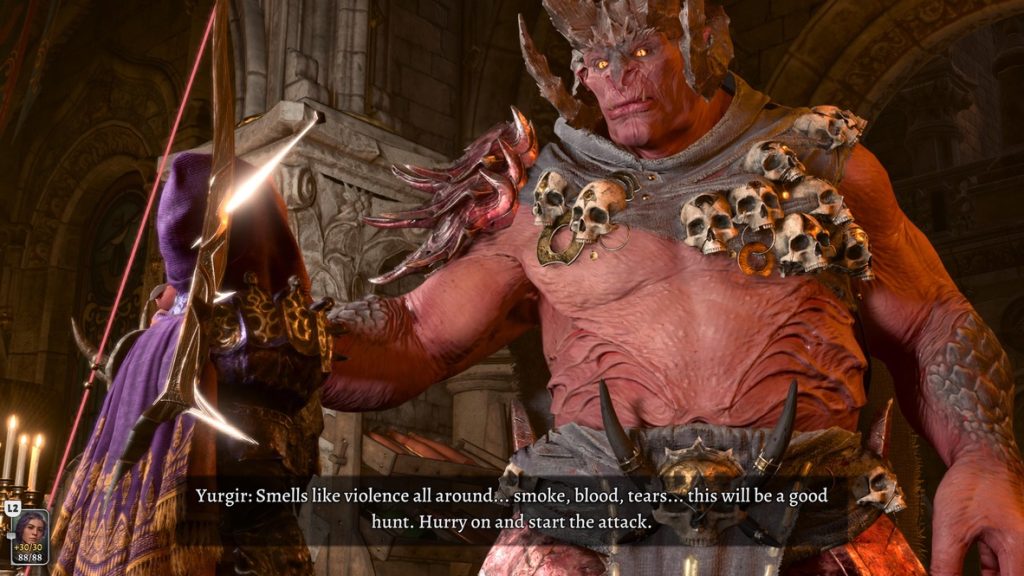
He attacked by tossing bombs at the Dragon. A shame that Laurelin was within the blast radius. Finally she was brought down.
The surviving party members confronted the Ultimate Evil. Laurelin was nowhere in sight. Sorcerer Sabrina did the most damage, and Astarion struck the final blow.
And then…
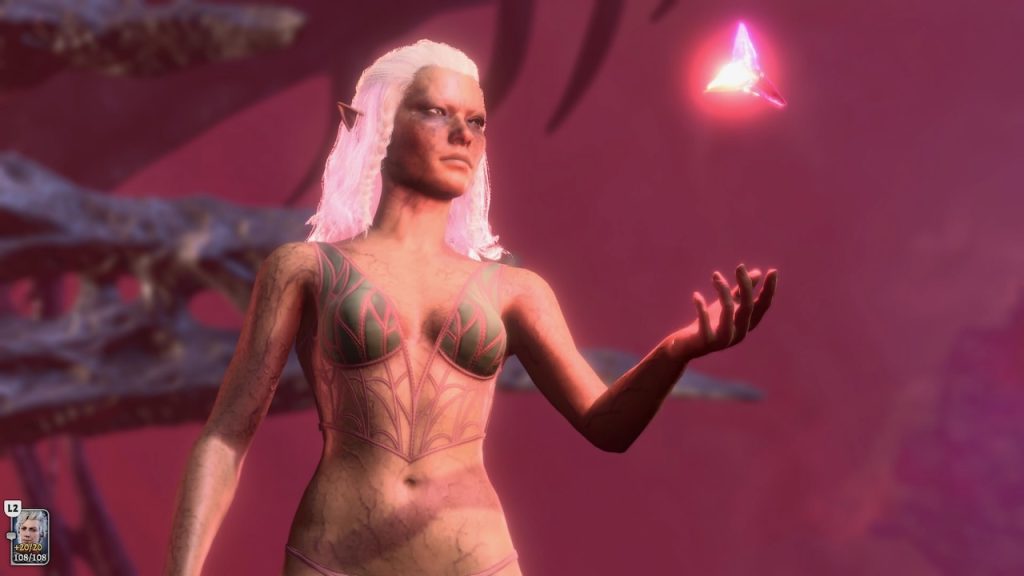
I gave up. Laurelin in her underwear was superior to Sorcerer Sabrina in full armor (see the image of Sabrina below in the End-game section).
I explored a couple of post-game alternatives. In one, Laurelin took dominion over the Ultimate Evil.
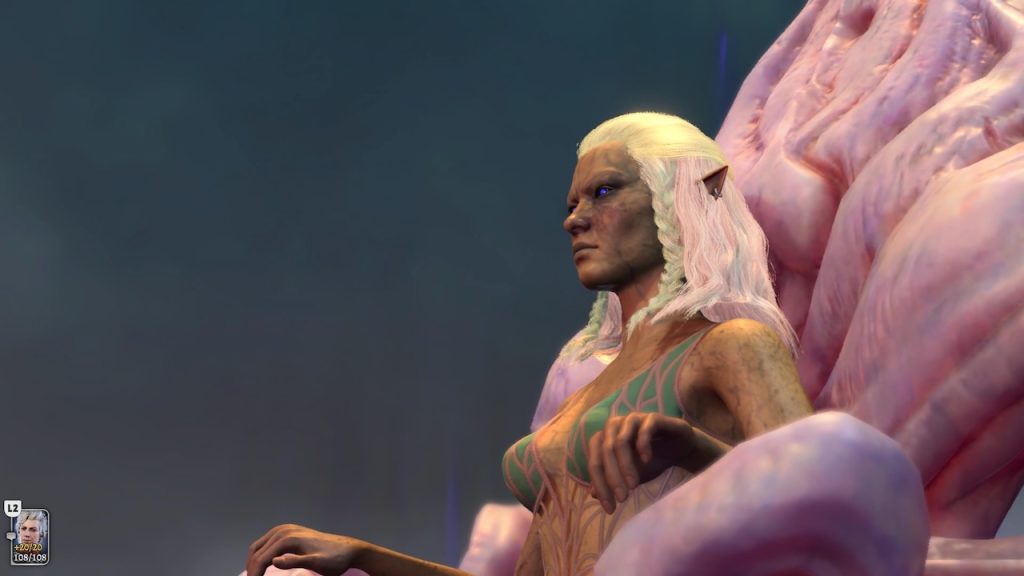

The other alternative was to destroy the Ultimate Evil, but take over Baldur’s Gate from underneath.

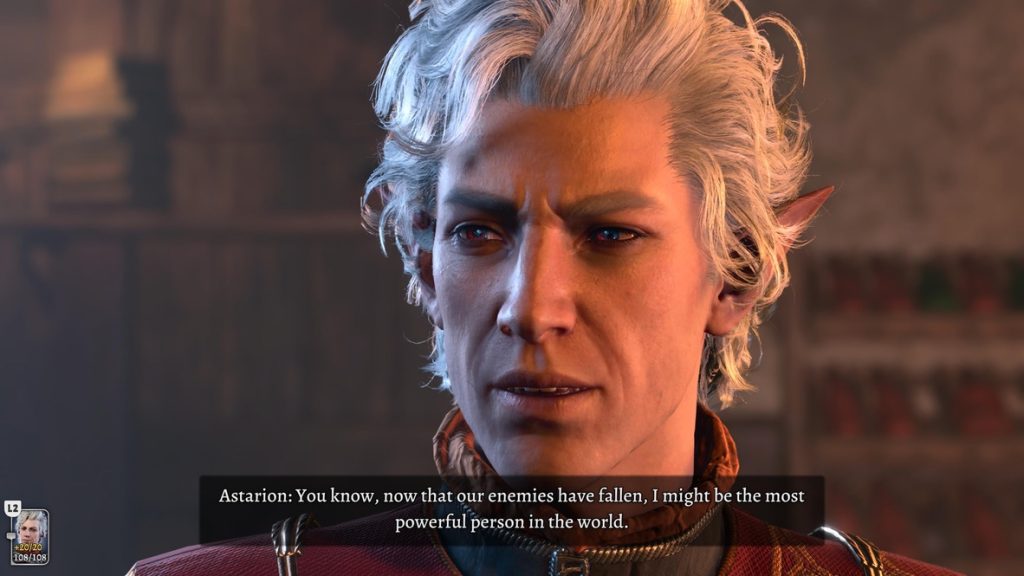
The others bid Laurelin farewell as she pursued her destiny.


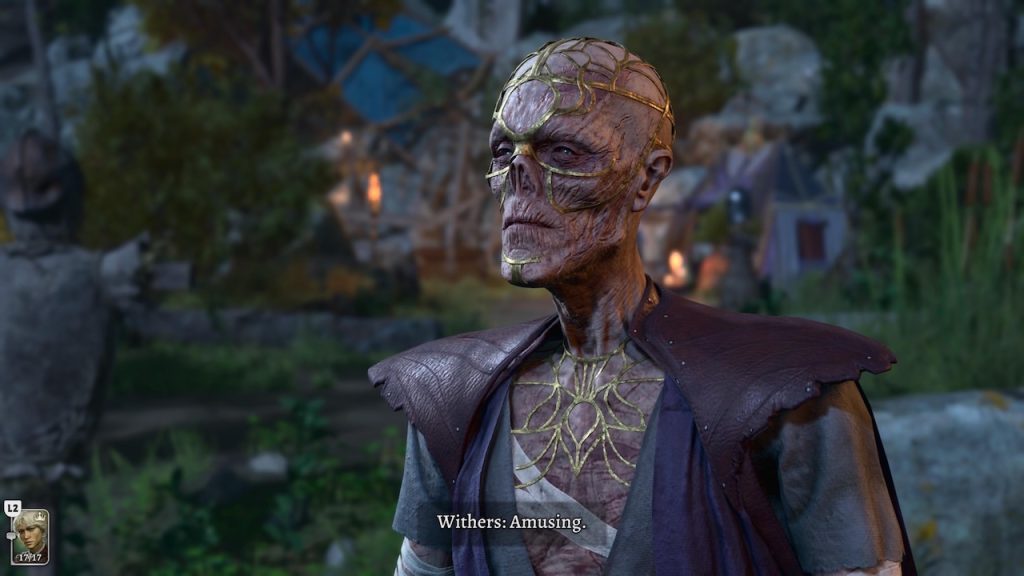
Plans for Playthrough 10
I’ve had enough of darkness, at least for now. I plan to explore builds that work with light.
- Lae’zel as an Eldritch Archer
- Wyll as an Eldritch Blast Sorlock
- Shadowheart as a Radiant Brawler Cleric
- Gale as a Retaliation Wizard
The Radiant Brawler Cleric and Eldritch Blast Sorlock both require the Callous Glow and Coruscation Rings. I’ll deal with that after I’ve acauired both and can compare the result between Wyll and Shadowheart.
Relationship goal: Wyll. After him, there’ll be one left to complete the list: Gale. He will have to wait until Playthrough 11 or later.
End-game – System
For my future reference, and for anyone who’s curious, here’s the final (non-bikini) look and stats for the characters at the end of the game.
Laurelin
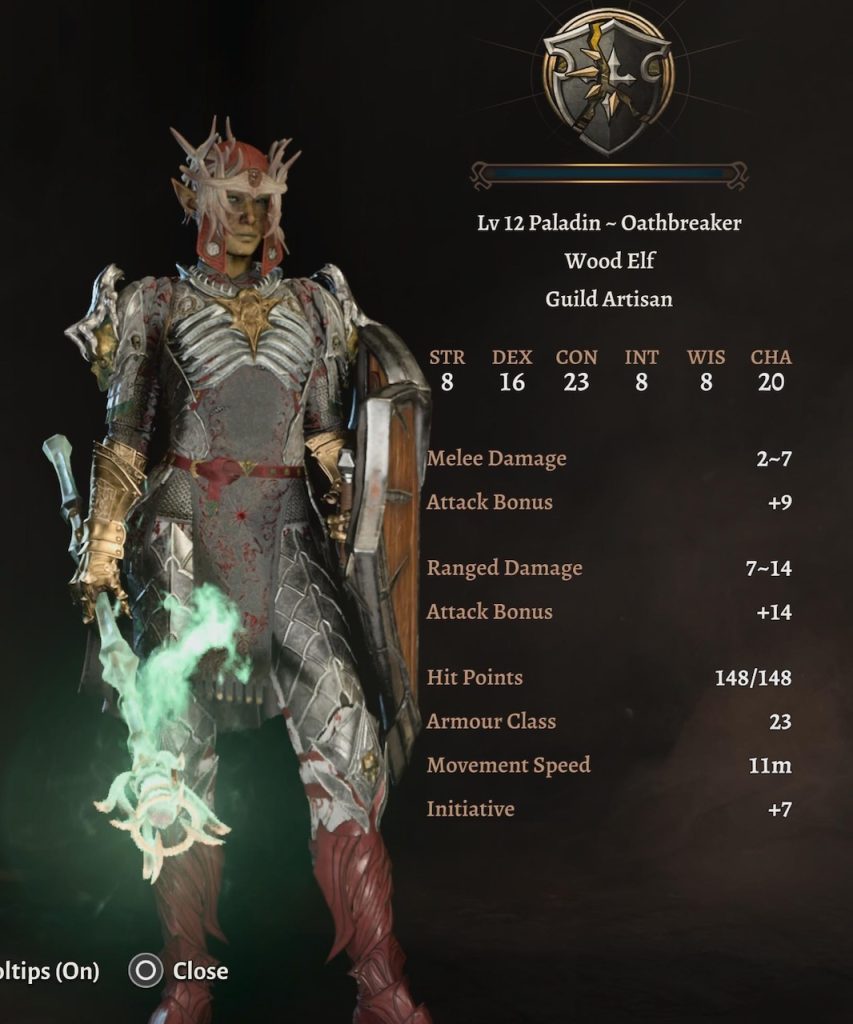
STR 8 (27 with Cloud Giant Elixir), DEX 16, CON 23 (with amulet), INT 8, WIS 8, CHA 20
12 levels of Oathbreaker Paladin
Also Astarion’s vampire spawn
AC: 23
Initiative +7
Spell Save DC total: 18
Spell Attack +13
Fistbreaker Helm
Cloak of Protection
Reaper’s Embrace
Distintegrating Night Walkers
Luminous Gloves
Band of the Mystic Scoundrel
Risky Ring
Amulet of Greater Health
Staff of Cherished Necromancy (via Magic Initiate Druid – Shillelagh)
Sentinel Shield
Gontr Mael
Sabrina
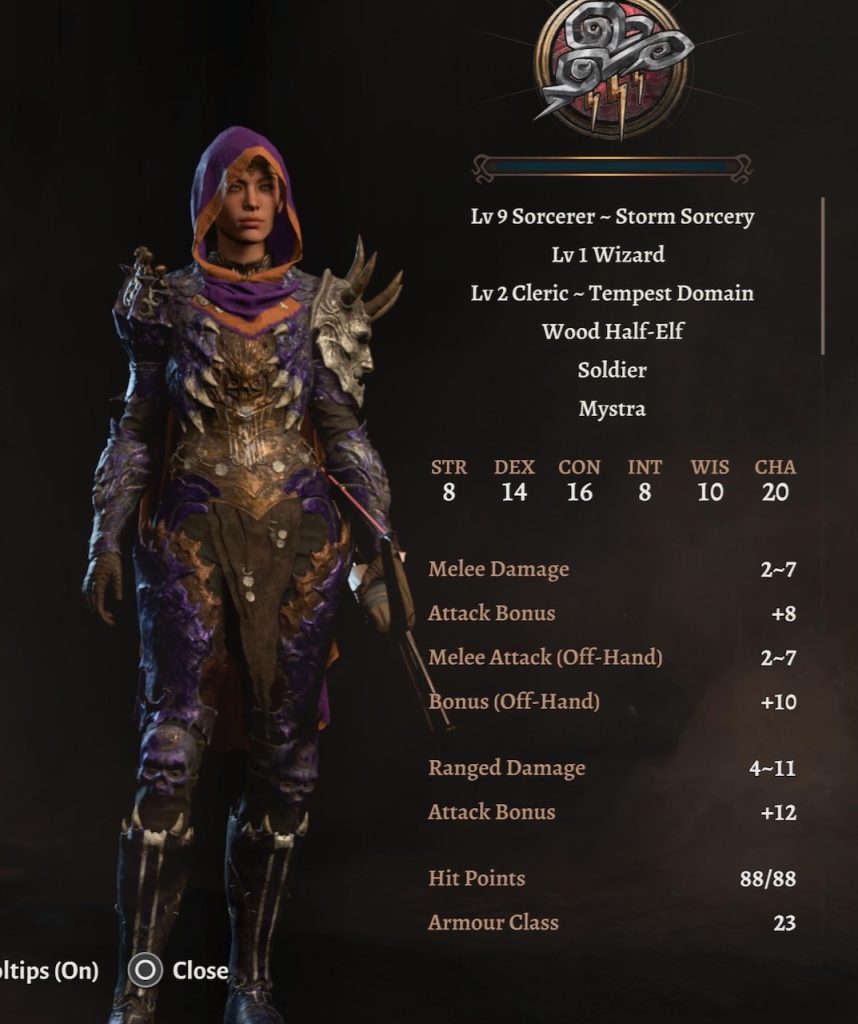
STR 8, DEX 14, CON 16, INT 8, WIS 10, CHA 20 (used Mirror of Loss)
9 levels Storm Sorcery, 1 Level Wizard, 2 levels Tempest Cleric
AC: 23
Initiative +5
Spell save DC total: 25
Spell Attack +18
Hood of the Weave
Cloak of the Weave
Helldusk Armor
Helldusk Boots
Helldusk Gloves
Eversight Ring
Ring of Protection
Amulet of the Devout
Markoheshkir
Staff of Spellpower
Hellrider Longbow
Astarion
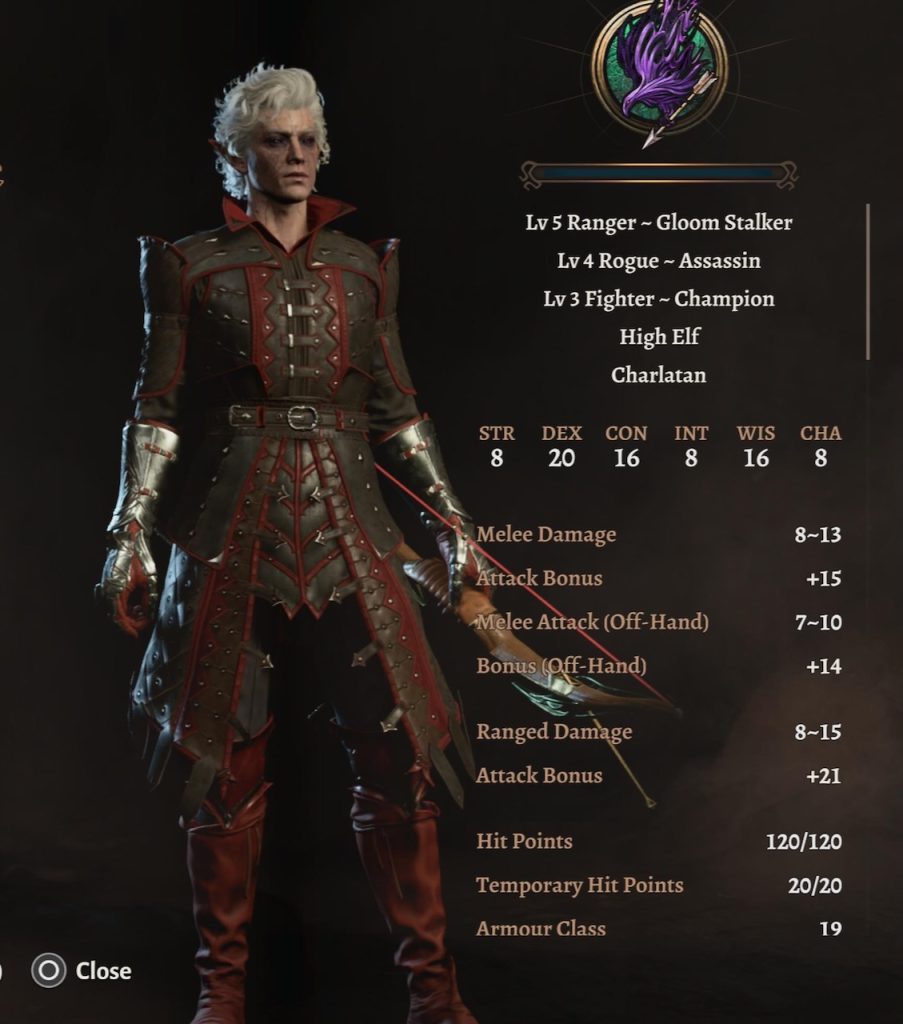
STR 8, DEX 20, CON 16, INT 8, WIS 16, CHA 8
Level 5 Gloomstalker, Level 4 Rogue Assassin, Level 3 Champion FIghter
AC: 19
Initiative +10
Spell Save DC: 15
Spell Attack +11 (but never cast offensive spells other than Hunter’s Mark)
Ranged damage attack bonus: +21
Total Crit bonus: +4 (with Elixir of Viciousness)
Sarevok’s Horned Helmet
Cloak of Displacement
Bhaalist Armor
Boots of Stormy Clamour
Craterflesh Gloves
Shadow-cloaked Ring
Shapeshifter’s Boon Ring (and stayed shapeshifted most of the time)
Amulet of Bhaal
Bloodthirst
Rhapsody
The Dead Shot
Karlach
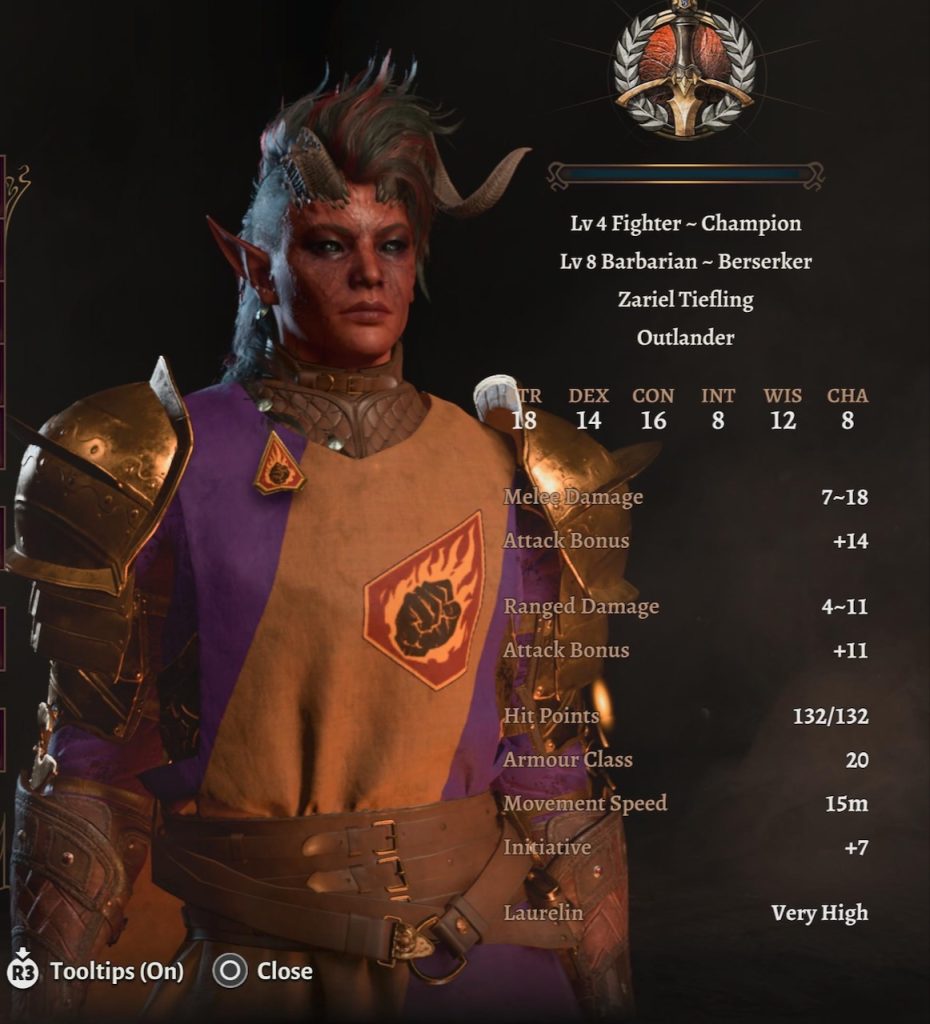
STR 18, DEX 14, CON 16, INT 8, WIS 12, CHA 8
4 Levels of Champion Fighter, 8 Levels of Barbarian Berzeker
AC: 19
Initiative +7
Helm of Balduran
Cindermoth Cloak
Flame Enameled Armour
Cinder Shoes
Thermoarcanic Gloves
Caustic Band
Ring of Flinging
Amulet of Misty Step
Hellfire Greataxe
Titanstring Bow
Pingback: Split conversations in MacOS Messages – The Argothald Journal
Pingback: Baldur’s Gate 3 – Playthrough 10 – Easing up – The Argothald Journal
Pingback: Baldur’s Gate 3 – Playthrough 11 – Romancing a Wizard – The Argothald Journal
Pingback: Baldur’s Gate 3 – Playthrough 11 – Wrapping it up – The Argothald Journal
Pingback: Baldur’s Gate 3 – Playthrough 12 – Relationships – The Argothald Journal
Pingback: Baldur’s Gate 3 – Playthrough 12 – More Relationships – The Argothald Journal
Pingback: Baldur’s Gate 3 – Playthrough 12 – Mods – Party of 14 – The Argothald Journal
Pingback: Baldur’s Gate 3 – Playthrough 12 – Wrapping it up – The Argothald Journal
Pingback: Baldur’s Gate 3 – Playthrough 1/14 – Fey and Bellandria – The Argothald Journal
Pingback: Baldur’s Gate 3 – Playthrough 1/14 – Problems and Plans – The Argothald Journal
Pingback: Baldur’s Gate 3 – Playthrough 2/14.5 – Raelia and Tavelle – The Argothald Journal
Pingback: Preserving BG3 game saves made on PS5 – The Argothald Journal
Pingback: Baldur’s Gate 3 – Playthrough 11 – A Hireling’s Destiny – The Argothald Journal
Pingback: BG3 – Alternatives to Fly – The Argothald Journal
Pingback: Baldur’s Gate 1 and 2 – The Argothald Journal
Pingback: My BG3 and D&D rules explanations – The Argothald Journal
Pingback: Real Angela’s playthrough 5 – Origin Astarion – The Argothald Journal
Pingback: Baldur’s Gate 3 – Playthrough 8’/2.5 – Renewal – The Argothald Journal